#ACD canon metaphors
Explore tagged Tumblr posts
Text
Don't think about Watson making Holmes up to compensate for his loneliness after his injury. Don't think about Watson sitting alone in his hospital bed conjuring up problems just to be solved by an enigmatic imaginary friend. Don't think about all the inconsistencies in the book being due to Watson's weakening health. Don't think about Watson killing off Holmes as a means of trying to support himself without living in his imagination but failing and having to bring Holmes back to save him. Don't think about Watson writing all those historical novels (which ACD preferred to write) as another outlet for his loneliness but ultimately always returning to Holmes because that was the man who saved him. Don't think about Watson putting himself down in the stories continuously because that's how little he thought of himself, but writing Holmes, someone he thought as superior, complimenting him to try and make himself feel better. Don't think about-
#currently in this mindset not going to lie#okay it might be a bit much to think of the ENTIRE Holmes stories being Watson's imagination#but#consider#hounds of baskervilles as a metaphor for Watson's grief#i'm going to explore that idea more so prepare for a long and confusing post soon#sherlock holmes#sherlock#acd#acd canon#john watson#dr watson#acd johnlock
180 notes
·
View notes
Text
Christmas Fic Masterpost
Figured I'd toss this up in case anyone's looking for holiday-themed stuff, specifically. All fics here are either set around holidays or themed accordingly, and I make no claims as to their literary quality, lol.
My BBC Sherlock and ACD Sherlock Holmes fic are not included in the list as they're not on AO3 yet, but they are available on request.
Star Trek TOS
Of Luck And Miracles (4.2K, Kirk & Spock)
A deliberately plotless piece of Original Series fluff for those of us who don't feel very Christmassy this year.
A Celebration in Infinite Combinations (60K, gen ensemble & OC)
The first year of the five-year mission is a critical time for the crew of the starship Enterprise. With a new chain of command, a new crew, and a new captain who must prove himself to both, all must work together and learn to function not as a crew, but as a family. Ten mini story arcs revolving around ten sets of characters, all converging in the last chapter.
Gifts (7K, Kirk & Spock)
Five times Jim and Spock gave each other something, and one time it wasn't necessary. Early-era TOS.
Star Trek AOS
New Beginnings (1K, Kirk & McCoy)
Jim's never really celebrated Christmas before, at least not with someone who actually wanted to be there. This is…new. (It's super weird.)
One Step Forward (9K, gen, Kirk & Spock focus)
Grounded on Yorktown base for the winter holiday season, the remaining crew of the U.S.S. Enterprise deal with being haunted by metaphorical ghosts of Christmases past. Full warnings inside fic.
Loki Series
A Light in the Window (5.5K, Loki & Mobius)
On the eve of the multiversal war, the God of Time and Director of the TVA rendezvous one last time in a tiny beach house in the Florida Keys. Set near the end of the Storyteller 'verse, about twenty years after the events of Ready or Not.
A Green Christmas (14.6K, Loki & Mobius)
Holiday fluff and potential tree-related punnage, that's all. You've been warned. Part Five in the Storyteller verse, set a few weeks after the events of To Begin Again.
BBC Merlin
None Goes His Way Alone (25K, gen ensemble post-S2)
Merlin has always thought that the sorcerer chooses the familiar; his new familiar begs to differ. Canon-compliant not-quite-fix-it fic for S5 finale.
And for anyone who, like me, is feeling a little jaded about the holidays, you can find a 100% angst-free, silly or fluffy self-recommendation for each fandom below the cut. 💙
Star Trek AOS
All's Fair (9.4K, gen ensemble cast)
He needs a staff that will call him on his bullshit, not blindly obey his every command; one that actually enjoys his company rather than tolerating it with a fake smile. One who has somehow, despite all odds and his own initial intentions, wormed their way under his skin to wrap around his heart. It would kill him to lose them, now. Also now, he wants to kill them. It balances out, somehow.
Star Trek TOS
Action & Reaction (2K, gen Triumvirate)
Or, The One With the Checkmate. Tag scene to A Piece of the Action.
Loki Series
Crossword Clues (2K, Loki & Mobius)
The infirmary of the TVA is where non-jet-ski magazines go to die.
#masterpost#fanfic#fanfic writing#star trek tos#star trek aos#loki series#bbc merlin#spirk#lokius#though these are all pretty gen ngl
23 notes
·
View notes
Text
Johnlock Fluff Rec List part 3!
As always, these can be set anywhere in canon or not at all, and are stories that contained more good feelings than anything else. <3
Fluff pt 1, Fluff pt 2
A Slice of Sentiment by darcylindbergh 9.6k
Sherlock Holmes has a secret. A hot, gooey, greasy, extra cheese and pepperoni secret.
And he’s waiting for the person—the right person, the only person, the capital-O One person—to share it with.
notes: eating pizza as a metaphor for love, will be rereading often
like a lover (or a partner in crime) by ivorysteel
John finds Sherlock's sketchbook full of drawings of just him and wonders why.
AKA Sherlock draws out his feelings.
notes: fluffy, flirting, john figures out his feelings, post s4 insomuch that it has rosie and mary is dead
A Good Old Fashioned Happy Ending by darcylindbergh 32.7k words
And Sherlock stands there, in the middle of a Christmas market as John hums along to Silent Night, John’s hand warm in his with fingertips a little gritty from the cinnamon-sugar doused churros they’d shared, and thinks, oh, that’s–that’s an idea, isn’t it?
For Christmas this year, Sherlock wants to get John something special: something every fairytale deserves.
notes: written for a 25days of ficmas, has 26 chapters, proposals
Of Small and Unexpected Things by wearitcounts 1.2k words
It’s by accident, the first time John sees them
notes: not quite fluff but not quite angst, john sees sherlock’s scars from his time after the fall
Feel your breathing by Mixxy @mixxtapej 2.1k words
And he was numb yet feeling far too much, he was back on that pavement, and his mind was buzzing far too hard, whispering you didn’t do it in time, Mrs. Hudson is dead, Lestrade is dead, your John is dead dead dead-
And then John’s hand was around his wrist, thumb rubbing over his pulse point, and Sherlock’s not sure if it was to comfort him or John but either way it worked
14 Days by a_4_patch_problem 5.9k words
And then Sherlock looked at the calendar, noticing the sickly cheesy red heart around the date, two weeks from then.
Valentines Day.
notes: Sherlock writes John lovenotes.
Let You Kiss Me (So Sweet and So Soft) by out_there 8.6k
The first time Sherlock kisses him, John keeps his eyes open, and so does Sherlock, and mostly, he wonders what Sherlock could possibly be up to. There'll be some logic to this. Some ridiculous experiment about body warmth or respiratory rates or testing a new way of picking pockets. Sherlock does the unimaginable for bizarre reasons, but behind it, there's always logic and curiosity. Sometimes, it just takes him a while to explain it to John.
notes: Sherlock trying to get John to stay
29 Days by naughtyspirit
For the prompt "John bets Sherlock that he can’t compliment someone every day for a month. It ends up many of these compliments are aimed at John and it leads to them kissing/confessing or whatever."
Of Midnight Moments and Mistletoe by huddersandhiddles (LeslieWrites) 7.6k
John and Sherlock are throwing a Christmas Eve party, and the flat is all strung up with mistletoe.
notes: first kiss, getting together during a holiday party
Honeybee by Ireallydontcare443 1.9k words
Watson experiments with nicknames, hoping to find one that will make Holmes' knees go weak.
notes: ACD
Thirty Blue Toes by Itsallfine 1.3k
John Watson had seen a lot of unexpected things upon entering 221b Baker Street. Somewhere along the way, he’d ceased being surprised.
Then he walked in on Sherlock having his toenails painted by an 8-year-old.
notes: Sherlock babysitting Lestrade's kid, not overtly johnlock, sweet
The Oolong Disaster by unicornpoe
John has a beard. Sherlock has a panic attack.
notes: frustrated Sherlock, loving wonderful John
Hypotheticals by ArwaMachine
John finally manages to confess his love to Sherlock.
Sherlock, of course, has questions. Lots of questions.
notes: insecure sherlock but this is fluff
The deepest Fear by Schattengestalt
Sherlock fears that he will lose John someday and he despairs when he believes his worst fear has come true.
notes: checking on eachother after nightmares, insecurities and love confessions, ambiguously series 1
31 notes
·
View notes
Text
Jolie's thoughts on
The Retired Colourman (Sherlock & Co. podcast)
This case, in ACD's original version, is the opposite of a favourite of mine. It's somewhat pedestrian, doesn’t have particularly memorable characters, doesn’t have particularly memorable deductions, and the only memorable dialogue or interaction is Holmes famously enumerating all the ways Watson should have used his charm to get the local ladies hot and bothered. Oh boy, that just changed a lot!
Lilian Barker - In ACD canon, Barker is Sherlock Holmes's "friend and rival", the other gifted and clever private investigator that just randomly pops up out of nowhere, never mentioned before and never mentioned again after… Weird, just weird. I prefer this Barker who finally gets a personality and a narrative function (other than being a painfully transparent red herring)!
Loved Sherlock going ballistic when she turns out not to have called the police, though. And how he keeps hating her even when she provides some useful evidence. (Thank you for not letting her actually solve the case though. I was worried there for a moment.)
Another plus: The deduction that the bad guy has a prosthetic leg goes absolutely nowhere in ACD canon but suddenly it becomes an important point!
Interesting dynamic between Sherlock and Inspector MacKinnon, too. Either Sherlock has realised that the police are not always idiots or MacKinnon is a very special person, in which case I want to know more about him and how he knows and why he trusts Sherlock. And how he managed to sell Sherlock & Co. to his superiors as a "third party investigation unit"!
Details I liked:
Did it take anyone else an age to realise that Amber Lee = Amberley? I‘m so slow.
John nattering away about low emission zones for a reason.
"The plot is thickening like a thick, evil… soup."
The chess metaphors! In ACD, the chess aspect just goes nowhere, except to serve as an explanation why the miserly, unsociable bad guy sometimes has a visitor at all. Great use of it here!
Sherlock "strangling" Mr Lee when he makes fun of John's injury, and then it turns out a pretty nifty move to secure evidence. (Or was it? Interesting question, hen or egg? I guess we'll be in sweet unknowing agony about this forever.)
Mariana = Mari? Sweet but uncomfortable at the same time, for obvious reasons.
I do love the confirmation that Mariana co-owns the business and is not just an employee, though.
"Don’t say juices, it’s a family show." - "You just said fuck."
John taking his frustrations out on the wall with a sledgehammer.
And then oh boy again for how dark this whole case is. Even Sherlock actually being really considerate and protecting Mariana from trauma took a pretty creepy form. Honestly, the way he said, "Follow the thought. Don‘t run away from it. It’s natural to be scared when you know what you'll find at the end of it.", I honestly expected for a moment that he was talking her into looking at the bodies, just from the tone.
I also can’t help feeling that that moment in the attic would have belonged to John, not to Mariana. I mean, yeah, she did deserve to reap the fruit of her earlier clever deductions about the water pipe system, and Watson is absent from the final resolution in ACD’s story, too… But I‘m not sure I can ever get over the fact that John did not hear Sherlock say "check mate" in that voice.
Reality check: The police are incompetent if they missed both the walled-off extension/basement and the walled-off part of the attic after a week of searching, and if they even considered taking the bad guy to court without having done that first.
Also reality check: Like with The Cardboard Box, straight up cruel and unimaginative domestic murder hits too close to home for me to be ideal entertainment, but then Joel Emory absolutely gets points for realism. What Sherlock and Mariana find at the end of the case - two human bodies having decomposed in water for a week - is straight out of ACD canon. The podcast version just calls the horror by its name, instead of elegantly glossing over it, and gets kudos from me for that.
Check out this amazing art for the episode by @abstractfrog (Sherlock and Mariana), and @subtlehysteria 's fantastic John with a sledge hammer!
#sherlock holmes#sherlock & co#sherlock & co podcast#podlock#sherlock and co#episode notes#the retired colourman
51 notes
·
View notes
Note
For the Fic Questions thing: 4, 7, 17 and 18? :O I'm curious!
Thank you for the questions! I haven't forgotten these (nor the others still in my inbox!); I'm just slow.
4. How many fic ideas are you nurturing right now? Care to share one of them?
So many!
Alas, you're anonymous, so I don't know what you'd most like to hear about, but playing the odds…
I have ideas for more Krakenverse stories -- but alas, they may be tragic ones. Most specifically, adapting the canon fates of the Hotspur and the Sutherland…
Or, on the Flight of the Heron front: you know that salmon-omegaverse post that's been floating around for a couple of months? Yeah. I've got several thousand words of that.
7. Share a snippet from one of your favorite pieces of prose you’ve written and explain why you’re proud of it.
From "All He Has to Offer":
But here his line of thought lost way, its keel dragging against the great submerged mass of his longing — a longing that was unspeakable, very nearly unthinkable, between captain and lieutenant.
I really enjoy devising a good maritime metaphor, given an appropriate point-of-view character. I was particularly proud of this one, especially since it brings to the surface (hah!) something that the pov character doesn't normally allow himself to think about. This particular line was a late addition to the story, which I had all but finished when I realized that the recipient had requested a slash story (Bush/Hornblower), and I had inadvertently written something where the shippiness was no more than subtextual. Solution: remake the implicitly subtextual shippiness into something that's explicitly submerged…
17. Do you write your story from start to finish, or do you write the scenes out of order?
Usually start to finish, although I've been known to skip ahead and write a scene out of sequence when I'm stuck. I don't do it often, though, because I usually have to rewrite it by the time I get there for real, the intermediate story not having proceeded exactly as I had anticipated it.
Stories that don't have a strong narrative throughline, however, might be written in any order. Most of my 5+1s have been written out of order, as was "Friends of Cordelia" (Vorkosigan Saga).
18. Do you use any tools, like worksheets or outlines?
I usually outline my longfic, noting down major beats and events I want to hit. However, my outlines are very much living documents, continually revised as I write: there's a lot that I don't know until I've written it, and each successive discovery affects things that happen farther downstream.
More than outlines, though, I'm a big one for building timelines! I have a timeline for the events that took place between Flight of the Heron and its immediate sequel, which I've used for a couple of different stories. "Drunkards, Lovers, and Fools" (Flight of the Heron) had a timeline working out Francis' birth year, Keith's birth year, and how old both of them were at various points. "Friends of Cordelia" (Vorkosigan Saga) has a spreadsheet working out how old Piotr, Aral, Cordelia, Miles, and several OCs all were at various points, as well as what year of the Vorkosigan Regency or Gregor's reign we had gotten to by then. "Langstroth on Bees" (ACD Holmes, unpublished) has a timeline that includes story beats, canon events, Doyle's publishing history, and historical events. I know that if I'm doing my job as a storyteller, no one is going to be calculating the dates as they read, but I don't want to run afoul of any dates someone might already know -- and in any case, it's easier for me if I have written down somewhere how old everyone was during key events. Instead of stopping to count on my fingers AGAIN, I can just look it up and go on.
Thank you for the questions!
5 notes
·
View notes
Text
Well, considering who reblogged this, our resident hellsite writer is either judging a book by its cover or he has read more fanfiction than he is letting on after all (I am joking ;-))
I wouldn't dispute the fact that lots of fanfics and fandom conversation are more apolitical than political but this post still irks me a bit every time it crosses my dash.
To take one example off the top of my head, one of my favourite fandoms, ACD canon (i.e. fanfic based on the original Sherlock Holmes stories is going through a phase of many authors writing Sherlock Holmes as trans, which is fascinating and made me read up on trans issues and history more than I otherwise would have). Many of the Holmes stories are "case fics" that absolutely deal with societal and political issues like poverty or repressive laws etc.
One of my first fandoms was unsurprisingly Star Trek, and Starfleet politics, interplanetary relations and wars etc. are very much part of these stories and as much a metaphor for what is happening in the world of today as the original series was a metaphor for things happening in the Sixties.
Yes, political issues are often sidelined in fanfic (just as they are in romance novels, for that matter), but I wouldn't go so far as to say fandom in general doesn't focus on these issues.
i think its really funny when people say they don't like political media and just want something 'cozy' and 'discourse free' then the media theyre talking about is like. miyazaki movies. or the moomins
49K notes
·
View notes
Text
Ships and Cars - The Sign of Code
There have been lots of discussions about code in BBC Sherlock, and the possible metaphorical meaning of different things that appear frequently in the show, such as coffee/tea, water/fire, dogs/cats and many more. This show indeed seems filled with ciphers, code and secret messages. In this meta (X) I tried to decipher the encrypted name of the fishing boat that Sherlock and John hijacked in TFP, when it was called upon from Sherrinford: “Golf-Whisky-X-ray”.
The Ship coding

At first I thought this was referring to the international spelling alphabet for wireless communication (X, X) where there’s a word for each letter. “GWX” didn’t make much sense to me, though, until I stumbled upon something deeper: ‘Golf’, ‘Whisky’ and ‘X-ray’ are also part of the marine Code of Signals (X) that was established in Britain around 1850. It’s still used by water vessels to communicate important messages regarding safety of navigation and such, and the signals can be sent by, for example, flaghoist, signal lamp or flag semaphore. Conan Doyle worked on a ship at least in 1880 and 1881, so the signals could totally have been known to him already in Victorian times. And since Sherlock and John are on board a boat in TFP,
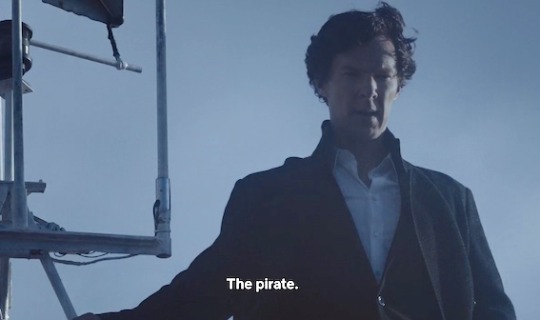
I think it’s reasonable to assume that the marine code is the relevant one here. In this signal code, the flags for “Golf”, Whisky” and “Xray” mean the following:
Golf = “I require a pilot.”

Whiskey = “I require medical assistance.”

”Xray = “Stop carrying out your intentions and watch for my signals.”

Which in other words could be read as:
I need a pilot (a maritime pilot to help me navigate)
I need a doctor
Pay attention to code
But is this use of marine signals something that only appears in BBC Sherlock? Is it Mofftiss’ own idea to use them, or could there possibly be any canon references to them? In the discussion that followed my meta (X) @frailtyofgenius pointed out to me that ACD’s canon actually does mention “Naval signals” in His Last Bow (LAST), which I think might be very significant. And the one who uses the naval signals is Holmes himself.
Continued under the cut, because this is reeeally a long ‘transport’... ;)
So I took to read LAST and realized that there are several ’naval’ references (my bolding) in this story by Conan Doyle. In the beginning, as a romantic landscape framework, we’re told about the surroundings of the German spy Von Bork’s house:
Above, the stars were shining brightly, and below, the lights of the shipping glimmered in the bay.
LAST takes place on the English east cost, near the port of Harwich. The spy Von Bork is chatting with Baron Von Herling, a German diplomat, bragging about the intelligence he’s gathered for his country, and then he shows the Baron the contents of his safe:
And all in four years, Baron. Not such a bad show for the hard-drinking, hard-riding country squire. But the gem of my collection is coming and there is the setting all ready for it.” He pointed to a space over which “Naval Signals” was printed.
But apparently the naval authorities have changed the code:
“But you have a good dossier there already.” “Out of date and waste paper. The Admiralty in some way got the alarm and every code has been changed.”
So Holmes, posing as the Irish-American spy Altamont, is supposed to bring new ones. I think the real ‘feature of interest’ in this story, however, is the coding that Holmes/Altamont uses in his telegram to the German spy:
“Will come without fail to-night and bring new sparking plugs. ALTAMONT.”
And the conversation between Van Bork and the Baron continues:
“Sparking plugs, eh?” “You see he poses as a motor expert and I keep a full garage. In our code everything likely to come up is named after some spare part. If he talks of a radiator it is a battleship, of an oil pump a cruiser, and so on. Sparking plugs are naval signals.”
So here in ACD canon we’re explicitly told that the spark plugs, the ignition of the car’s engine (which generates an explosion in the engine’s combustion chamber) actually represents code - marine code. And other car references, according to Van Bork, are also marine code. I can’t help wondering if water was actually meant to represent emotions already in canon? ACD canon is packed with references to water: sea, coast, lakes, ponds, rivers and waterfalls but also ships, steamers, boats, submarines and such. Some of the criminals in canon are seamen and the navy is mentioned in some cases. And in two stories (NAVA and BRUC) the ‘naval’ issues contain secrets of national importance.
I’d love to try to analyse all the water and boat references in ACD canon and see if/how they tie into emotions, but that’s for another meta. :) But what if something similar is done in BBC Sherlock; what if Mofftiss have used not only canon’s water metaphors for emotions but also the same general secret cipher as Holmes used in LAST? But maybe Mofftiss also took the cipher one step further, interpreting anything car-related not as general metaphors for emotions, but specifically as code for sexuality.
In TFP there’s a great explosion at 221B, and next thing we know, Sherlock and John are aboard a fishing boat, which is called upon with naval signals. But there’s actually very few ships in BBC Sherlock (while canon, as mentioned, is full of them); the fishing boat in TFP is one of very few boats in the show. As for seamen, there’s also very few in the show. Except for the fishing father and son in TFP, there’a also Sherlock’s deductions about the unemployed fisherman and his mother in THoB. @sagestreet has written an excellent meta suggesting a significant symbolic meaning of ‘fishing’ in this case (X).
In this self-censored post on John’s blog, however, there’s a cruiser mentioned in the title: Tilly Briggs Cruise of Terror. But we never get to know anything about this case; the post is taken down entirely since, according to John, “the ship’s owners are launching an appeal”.
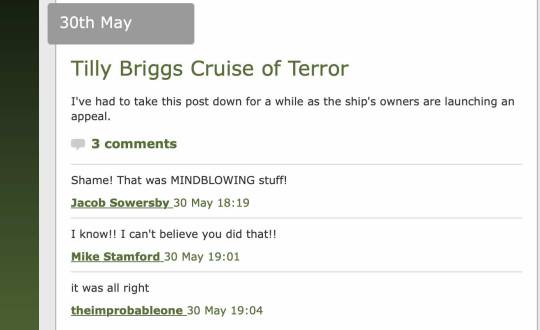
Why is this post even there, if no one is allowed to read it? Every other blog post from John has some kind of content in it - at least since he met Sherlock. But this one only has a title (and a teaser in the post before: “I'm going to tell you about a couple of the smaller cases we've been involved in. What really happened on the Tilly Briggs pleasure cruise.” (X))
So the supposed ‘pleasure cruise’ was turned into a ‘cruise of terror’ and then deleted. Maybe it’s just me, but I strongly suspect this is a clue from the show makers telling us that a certain ‘ship’ is not allowed in BBC Sherlock, for ‘legal’ reasons having to do with the ‘owners of the ship’ (ACD Estate).
Actually, there’s more info than this about the ship even in ACD canon, although it���s scarce. In The Sussex Vampire (SUSS) “Matilda Briggs” is mentioned in a letter to Holmes from the company Morrison, Morrison, and Dodd:
“As our firm specializes entirely upon the assessment of machinery the matter hardly comes within our purview, and we have therefore recommended Mr. Ferguson to call upon you and lay the matter before you. We have not forgotten your successful action in the case of Matilda Briggs.”
After Watson has read it, Holmes explains to him (my bolding):
“Matilda Briggs was not the name of a young woman, Watson,” said Holmes in a reminiscent voice. “It was a ship which is associated with the giant rat of Sumatra, a story for which the world is not yet prepared.”
If this is an allusion to a possible relationship between Holmes and Watson, indeed the world would not have been ‘prepared’ in Victorian times, since homophobia was prevalent and same-sex couples illegal.
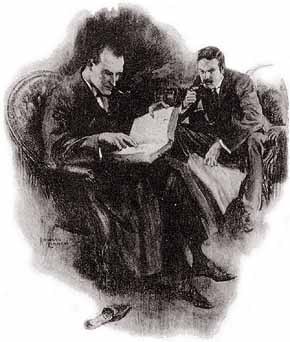
Source: (X)
Directly after this, while perusing his lexicon for ‘Vampires’ (the actual topic of the letter), Holmes also mentions another ship that was associated with Victor Trevor’s father’s secret past as a mutinous convict:
“Voyage of the Gloria Scott,” he read. “That was a bad business. I have some recollection that you made a record of it, Watson, though I was unable to congratulate you upon the result.”
Indeed this voyage in GLOR was a ‘bad business’; it ended in mutiny and disaster. The ship Gloria Scott exploded and sunk in the Atlantic, and most of the crew and passengers died.
So, not many ships appear in BBC Sherlock. But instead, there’s plenty of cars in the show. What if all these car references actually somehow actually refer to a ship - a very particular ‘shipping’? ;)
The Cars
So, might these cars code for some hidden secrets? And/or is it possible to tie the car references to ’naval code’, as Holmes claims to do in LAST, assuming that naval = water = emotions but also sexuality?
Returning to canon, please note that Holmes and Watson (both in disguise) arrive in a car to the scene of this story in LAST. This is one of the very few cars that appear in canon, since they weren’t yet very commonly in use by those times. Holmes’ and Watson’s car is modestly described as “a small car” and “a little Ford” (as opposed to Baron Von Herling’s car, which is a huge limo). But at the end of the story, Holmes says about the little Ford: “Start her up, Watson, for it’s time that we were on our way.” And there they go, happily together, with the criminal tied up in the back seat, heading for Scotland Yard. Sweet, isn’t it? :) This is the very last we see of Holmes and Watson in canon. (Unfortunately, I can’t find any illustration of it).
BBC Sherlock, however, is full of cars. So, if we apply this analogy to BBC Sherlock, what car references can we find that could be translated into marine (= emotional) terms? Well, the first thing that comes to mind is the cab, the taxi, which is Sherlock’s preferred means of transport.
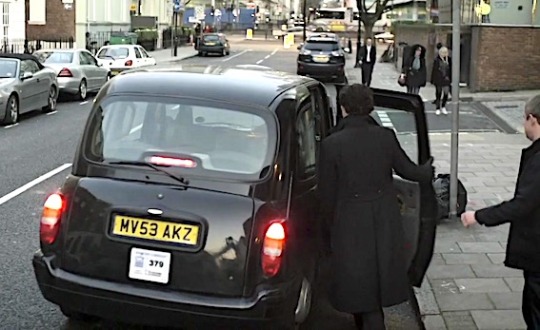
A taxi has a driver, which is the word that the little girl on the plane in TFP uses instead of ‘pilot’. But we don’t see any taxi boats in the show, do we? In the Unaired Pilot, however, the cabbie drives Sherlock home to Baker Street (not to Roland Kerr’s), and there he tries to ‘kill’ him. One could even assume he makes a kind of sexual innuendo when Sherlock is sprawled face-down on the floor and the cabbie says “I could do anything I wanted to you right now, Mr ’olmes.”
As I explained in my other meta about marine code (X), a marine pilot is someone who leads a ship through dangerous waters. Mofftiss haven’t included any marine pilots in their show, but they do use aircraft pilots, even if they’re not labelled as such:
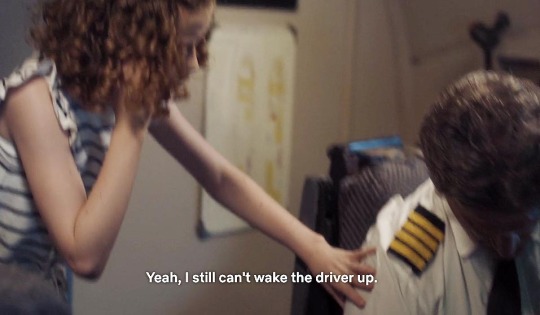
But if ‘driver’ should be read as ‘pilot’, then Jeff Hope - a John mirror - in the Unaired Pilot, the ‘driver’ of the show, guides Sherlock home emotionally and sexually, doesn’t he? ;)
But there’s more about the signals in LAST. This is what the counter-agent Sherlock ‘Altamont’ Holmes says when he arrives at Von Bork’s place:
“You can give me the glad hand to-night, mister,” he cried. “I’m bringing home the bacon at last.” “The signals?” “Same as I said in my cable. Every last one of them, semaphore, lamp code, Marconi – a copy, mind you, not the original. That was too dangerous.”
This seems very similar to Wikipedia’s explanation of the Marine Code of Signals, as I quoted above: apart from flag hoist, the signals can also be transmitted by, for example, flag semaphores, radio communication or signal lamps. We do have radio communication in TFP, when Sherrinford receives the message from the boat ‘golf-whisky-x-ray’. But are there any signal lamps in BBC Sherlock? Yes, in fact there are - and they’re tied to a car!

A blinking, grinning Peugeot, no less, in THoB. And it’s definitely connected to sex, because that’s what’s happening inside. ;) Even if we’re lead to believe that this isn’t actually code, John does try (unsuccessfully) to decipher the blinking lights from this car as Morse signals and gets “U M Q R A”.

Apparently this code is not referring to the Marine Code of Signals. But @bug-catcher-in-viridian-forest has written an excellent meta (X) deciphering the possible code “UMQRA” as meaning “TORCH”, using the Ceasar cipher, which Sherlock refers to on his website (X) in combination with another cipher. In my opinion this does make a lot of sense. John does indeed use a torch to try to decipher this message, and there are also lots of other possible metaphorical meanings of ‘torch’ in the show.
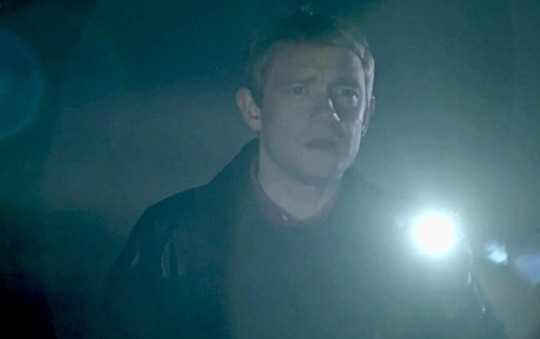
So I think it would still be wise to pay attention to code, wouldn’t it?
As for Holmes’ quote from LAST above, “a copy, mind you, not the original”, I’d interpret this at Holmes pointing out that these signals can be copied (’mirrored’?) and also that they can vary in type (I imagine that ‘Marconi’ stands for radio transmission (X)). All in all, these naval signals are of national importance in canon, just like the Bruce Partington Plans and the Naval Treaty. And these are all military top-secrets clearly connected to the British navy. At some point in LAST, believing he has won the spy game, the Baron says:“There may be other lights within the week, and the English coast a less tranquil place!” Seems like the East Wind is coming. ;)
But back to the marine codes and cars: in canon (LAST) the car references hide secrets of national importance, connected to Britain’s naval defense, and some of those secrets, in turn, are encrypted with naval signals. That’s double coding, right? Also: the navy defend British waters and water = emotions.
As for cars, there’s a lot more of them in the show, while canon has very few; cars weren’t in use during most of Holmes’ career. I think LAST is the first time that cars appear in ACD canon? And the spare parts that Holmes/Altamont talks about as code in LAST never actually appear in the story, only the Baron’s limo and Holmes’ little Ford, where Watson is the driver.
But in the modern show there’s plenty of cars, of course; they’re literally everywhere. Many people have long ago pointed out that cars represent transport metaphorically, which is how Sherlock views his bodily needs in the unaired Pilot. Which ties in well with the assumption above that cars also represents sexuality, which is related to emotions even if it’s not the same thing.
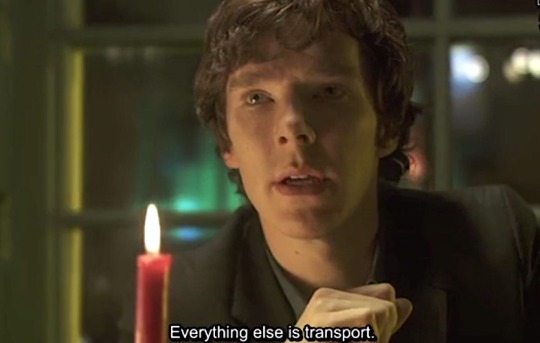
But let’s also try to decipher the car references with Holmes’s code in LAST in mind, shall we? Where can we find water and/or possible hints about emotions and/or sexuality?
Apart from the taxis, which run like a red thread through the episodes (ASiP, TBB, TGG, ASiB, TRF, HLV, TST), and the abundance of police cars and ambulances, I can think of the following:
Mycroft’s black governmental car which is used to kidnap John in ASiP (and other episodes).
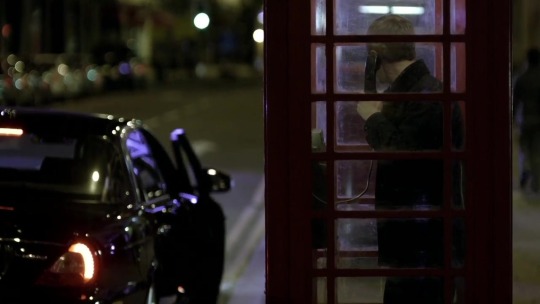
If Mycroft represents Sherlock’s brain, this might be about Sherlock trying to examine and test John with his intellect, to get an idea of who John is and what to expect from him. But this task is driven by his car - bodily needs - and behind them there’s still emotions, if we apply Sherlock’s code in LAST.
The first hostage’s car in TGG, where she is wrapped up in semtex.
This woman is literally trapped inside her car and metaphorically trapped inside her bodily needs, which are threatening to explode (remember Holmes’ ’sparking plugs’ in LAST?) if Sherlock doesn’t solve the puzzle about Carl Powers. And in this screen cap she is literally juxtaposed to Sherlock:
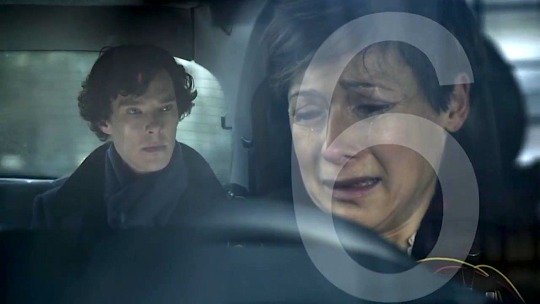
So it seems like Sherlock is now trapped inside his ‘transport’, yes? Still driven by emotions rather than intellect. And he probably sees this as very dangerous.
The finding of The ’dead’ man’s car with (fake) blood in TGG.
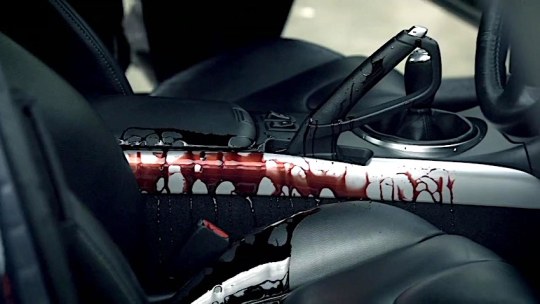
This ill-treated transport device (John calls it ”an abandoned sports car” on his blog X) leeds to more cars - Janus cars - and it turns out that the driver - Ian Monkford - isn’t dead; he’s just on ’vacation’ in Colombia (with the real purpose of cashing in his life insurance money). Sherlock figures this puzzle out and the poor fellow wrapped in semtex can breathe out; he’s not going to explode, either physically or emotionally. And no-one is dead in this case, but the driver faked his own death to avoid exposure and get his ‘security’.
The car with a dead body in the boot in ASiB

Licence plate: PYO3 HYN. The dead man in this car was destined for Germany according to his tickets - another ‘vacation’? But he never reached there; his plane crashed but he wasn’t in it, because he was already dead - trapped in his transport a car. Now, this case seems intimately connected with Sherlock in the boot of Mrs Hudson’s Aston Martin in TLD (see below). Except that Sherlock was being transported alive in that boot, but this guy is dead.
The client’s back-firing old SAAB in ASiB

The client stops near a wetland area and a stream because of problems with his engine. The driver - a John mirror? - tries to fix his ‘engine’, but the old car just won’t start. Sherlock analyses this case in his (drugged) Mind Palace together with his libido Irene Adler.

People have pointed out long ago (sorry for not remembering who - was it LSiT?) that the back-firing SAAB engine in the hiker case in ASiB might represent John’s dysfunctional sexlife with women; Sarah in specific and probably their trip to New Zeeland after TGG. (Maybe this is also why Sherlock in TSoT, when John has just been married to Mary, deduces that one of the wedding guests - a doctor - has ‘erectile dysfunction’?)
Irene’s black car in ASiB
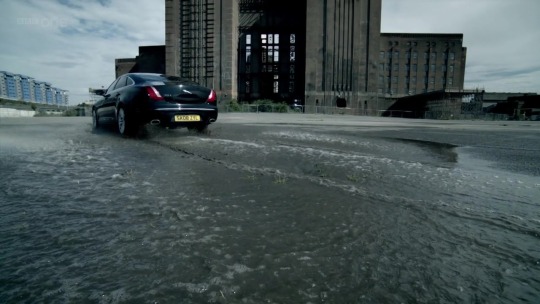

Licence plate: SKO8 ZYL. This black car, which has a private driver, is used to transport John to the Battersea station on New Year’s Eve in ASiB. In spite of being in midwinter, Battersea seems to be flooded with water. And this is the place where Irene exposes John’s sexual relationship with (or at least interest in) Sherlock while Sherlock is listening to the conversation from another room, but John declares that “I’m not actually gay”. This car is so similar to Mycroft’s black car (see above) that John thinks this is Mycroft who kidnaps him again. If Irene represents Sherlock’s libido, what does her black car stand for?
Sherlock’s and John’s hired Land Rover in THoB

Licence plate: OEI0 HFK. The Land Rover is a British car, known for its four-wheel drive and vast off-road capacity. Sherlock drives this car to “deepest, darkest Devon” with John in the passenger seat, so it seems like they were prepared for a ‘bumpy ride’. And this car actually has a visible spare part; an extra wheel in case of emergency:

And their journey really became ‘bumpy’ - at least on an emotional level, since they were both dosed with a fear-inducing gas, had a quarrel, and the gay couple who were running the Inn where they were staying took for granted that they were indeed a couple too.
John’s and Mary’s car in HLV and in TST

Licence plate: SP56 LJY, black Audi. Mary is the driver in HLV. (By the way, why has this car the steering wheel to the left, in a country with left-hand traffic?). Here we’re presented with the interesting idea from the billboard that “Information is the power to change 1895″. In HLV we actually do see something like a spare part for this car; John’s tyre lever. ;) (which looks more like some sort of pipe key, if you ask me, but whatever; it’s still a spare part - or at least a ‘tool’ - associated with John’s transport car):
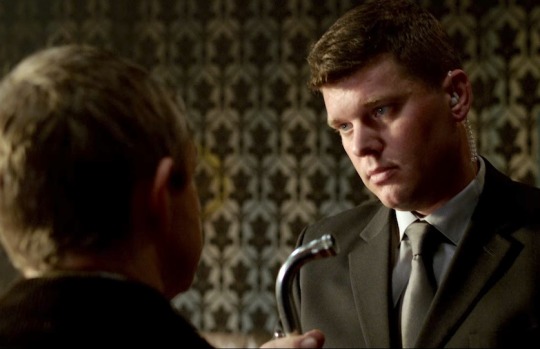
So this would be consistent with Holmes’ cipher in LAST. And this spare part is treated with very sexual overtones in HLV, so I think the influence of Sentiment and Sex is pretty clear here.
Mrs Hudson’s red Aston Martin in TLD

License plate: APIS CXJ. Now, this is a really interesting and beautiful car I think, and it shows its capacity when it goes speeding in TLD. Mrs Hudson has more resources than some people might believe. But John is only allowed to use her sports car - the ultimate symbol of male virility - when he’s off to rescue Sherlock. ;)
The license plate reads APIS, which I’m sure is a reference to bees and bee keeping, because Apis mellifera is the scientific name of the honey bee. Holmes’ main occupation as retired in ACD canon is bee keeping, which is shown in LAST, where his secret ‘sparking plugs’ turn out to be the Practical Handbook of Bee Culture. ;)) So Holmes stood by his words in his telegram to Van Bork; he did “come without fail to-night” (he came together with Watson) and he did “bring new sparking plugs”. It’s just that the ‘spark’ wasn’t maybe of the sort that Van Bork had expected...
Anyway, in this scene in TLD, Sherlock is being kidnapped and handcuffed by Mrs Hudson and transported in the boot of that sports car; he’s literally trapped inside the rear end of his transport, which has John as its direct destination.

Sadly for all of us, however, John refuses to ‘examine this body’, and this is instead done by the John mirror Molly (inside an ambulance), who tells Sherlock that he’s dying and that “it’s not a game”.
The next time we see this red sports car, however, John is the driver, and he’s using its great capacity as it should be used: to come to Sherlock’s rescue. ;)

Come to think of it, there’s actually at least one more car spare part mentioned in the show, even if it might not be meant as this specific part:
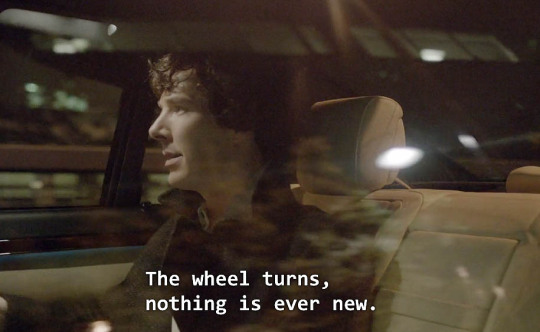
This car has a steering wheel nevertheless, and Sherlock is sitting in the car while saying this. And yes; this show is indeed repetitive when it comes to certain topics. Like ‘transport’, emotions and bodily needs. But I do hope we’ll finally see some new turns on this topic in the next series. ;)
Thanks for your patience in following this marathon meta to its end! Tagging some people who might be interested (please alert me if you don’t want to be tagged):
@raggedyblue @ebaeschnbliah @gosherlocked @sarahthecoat @lukessense @therealsaintscully @thewatsonbeekeepers @sagestreet @tjlcisthenewsexy @thepersianslipper @loveismyrevolution @shylockgnomes @frailtyofgenius
Screencaps in this meta are in some cases borrowed from this site (X).
98 notes
·
View notes
Text
This is a genuine question for people living by the sea: Are birds attracted by lighthouses? Or do I missinterpret something because I'm not a native speaker?
I'm re-reading "The Man With the Twisted Lip" and Watson states: "Folks who were in grief came to my wife as birds to a light-house."
I just feel like this is an odd metaphor. But maybe just because I've maybe seen a lighthouse 3 times in my life and don't know much about sea birds.

137 notes
·
View notes
Text
BBC SHERLOCK
I figured out people on mobile can’t see my pages and so cannot access my bbc sherlock meta, ergo a post.
META
► UMQRA
UMQRA = TORCH
UMQRA = TORCH - Just ONE (+ London Spy)
UMQRA = TORCH - See no more (+ Doctor Who)
What would it sound like if “UMQRA” was replaced with “TORCH”?
UMQRA = TORCH = LOVE, substitutions in the dialogue
UMQRA - Masterpost
UMQRA - Ciphers 1/2
UMQRA - Ciphers 2/2
► IOU
I O U = 2 + YOU
I O U = IT IS JOHN
I O U - Masterpost
► SHORTHAND
Does John Watson take shorthand notes? (+ ACD Canon)
The Foreman’s Shorthand - Masterpost
The Foreman’s Shorthand - Lines: 1st, 2nd, 3rd, 4th, Above the 1st
Was the foreman already under threat in the “Shorthand scene”? Is the foreman a Sherlock fan?
Does “You or Me?” mean “John or James?”
YOU = JOHN and ME = MORIARTY in the dialogue
► NUMBERS
57 and 207 as 007
57even Moffat (+ Doctor Who)
57 as a reference to “The Man Who Was Wanted”
57 STARS + 1 JOHN (+ Doctor Who, + London Spy)
From 57 to 1 (+ London Spy)
Operation 57 (+ Doctor Who)
A 57 in the licence plate
A 57 in a telephone number
57 and inverted 1895 in webpage
A 189- in the dialogue
11 is a pair of 1s
The Other One/Oswin/Osgood and replacing the Other One.
Up to 11
747
125 = ABE
The Other 1058 theory
44 = M
2,11 and 4
178H could be 1780 Herschel
Sonnet 14 and STARS (+ Doctor Who)
197 TPH = 1970, The Private Life of Sherlock Holmes
► RELIGIOUS REFERENCES
Jesus had a blogger called John
► ACD CANON REFERENCES
XXX as the sign of the three
► HIDDEN MEANINGS
Cupid, lions and Omnia Vincit Amor
The Blind Banker: hic sunt leones
Corporal Lyons’ Insignias of Love
The moon is a shark
Who’s who in the Solar System metaphor?
The Moon Lamp and the Sun decoration
Sherlock, his evil twin and the moon magnifying glass
The white bear problem
Hidden Williams in surnames
Hidden Will in The Great Game
WELL I AM = WILLIAM
MISS M(ary) E(lizabeth)?
MAID M(ary) E(lizabeth)
Shooting and missing
Does the violin miss MI?
Miss me? = Kiss me?
A cock ring
Metaphorical trash = Sherlock and John
Red Bird, Ginger Bread, Red Bride and Ruby Bread = Red Beard
Janine = M-Aggie?
Punch de la Lune
I, the Information Point
Cow = Character A and the A Frame
Human red signal
221 Bring It = 221B Ring It
Sherlock’s high on pot (lost link)
BBC LOCKED
What are you, Mikipedia?
Mycroft as a Weeping Angel
► EASTER EGGS
Give James Dancing Lessons
Easter eggs in John’s newspaper
Sharl-like pots in Magnussen’s office
Sherlock and John at falls in Doctor Who
YOU + TORCHWOOD easter eggs
► GENDER AND SEXUALITY
Sir William Gay
Rainbow letters in the trailer (lost link)
Bi The Way
John leaves a rainbow trail.
Bisexual pride scarf for Watson
Human bi flag
The Bi Ball
Alex & Ajay = A lesbian & A gay
► PREDICTIONS
Whodunit tricks, Janine’s reaction to marriage proposal and everyone’s reactions to the “Did you miss me?” video
Is Mary responsible for the “Did you miss me video?”
Lady in Red as The Evil Queen?
Is John is the treasure of the game?
Mary = The Other One - Masterpost
Has Sherlock got a sister called Elizabeth? Is she Mary?
“Miss Me?” as Sherlock’s sister theme
Is Mary responsible for the “Did you miss me video?”
Is Lady Smallwood the Other One’s mother? Or is she Mary’s mother? (lost link)
Did the Other One drown?
Is The Abominable Bride a lot about the Other One?
Mary as the Other One, s4 additions
Mary and the Black Pearl
MISS M(oriarty) E(lizabeth)?
► CHARACTERS
Now, Clara. Who’s Clara? (+ Doctor Who)
Sholto and Dimmock as a mirror for John and Sherlock
Why is the bride called Emelia?
Rory Arthur Williams comes from Moriarty and Sherlock
Hey! The flirting villain!
► PARALLELS: TALES AND FAIRY TALES
Fairy tales - Masterpost
Sherlock as the White Swan and the Ugly Duckling
Mary and Bonnie as the Black Swans (+ Doctor Who)
Sherlock vs The Swan Princess
Sherlock as Sleeping Beauty
Rosemund Watson as Sleeping Beauty
The Lying Detective as The Sleeping Beauty
Sherlock as Snow White and True Love’s Kiss (+ Once Upon A Time)
Sherlock as Pinocchio
Mary as the Blind Witch
Alice in Wonderland tea cup and Mrs. Hudson as the Mad Hatter
Mycroft as the Little Mermaid
Sherlock and Clara as Jack and the Beanstalk (+ Doctor Who)
Magnussen as Cruella De Vil
Mary As Robin Hood
The Holmeses have sorcerer’s hats
John as Brünnhilde
Episode speculation: The Yellow Trace and The Wonderful Wizard of Oz parallels
Episode speculation: The Dancing Man and Cinderella parallels
Episode speculation: The Second Star and Peter Pan parallels
The Abominable Bride vs Frozen
Eurus as the Snow Queen
► PARALLELS: TV SERIES
Sherlock vs Xena: Warrior Princess - The Abominable Bride vs The Bitter Suite?
Sherlock vs Xena: Warrior Princess - The Unaired Pilot vs The Greater Good
Sherlock vs Xena: Warrior Princess - A Study in Pink vs The Royal Couple of Thieves
Sherlock vs Xena: Warrior Princess - Series 3 / 4 vs A Cradle of Hope
Sherlock vs Xena: Warrior Princess - The Abominable Bride vs The Dirty Half Dozen
Sherlock vs Xena: Warrior Princess - The Six Thatcher vs Maternal Instincts
Sherlock vs Xena: Warrior Princess - Magnussen vs Ming T’ien
Dialogue comparison: high-functioning sociopath
Offensive: an Implication of impropriety (+ Doctor Who)
Dealing with falls = Changing the future = Marriage (+ Doctor Who)
The Lying Detective vs Blink
► PARALLELS: MOVIES
Sherlock vs The Private Life of Sherlock Holmes - Emile the husband, Emelia the wife
Sherlock vs Rebecca - His Last Vow vs Rebecca
Sherlock vs The Birds - The Hounds of Baskerville vs The Birds
Sherlock vs The Matrix Trilogy
Sherlock vs Dellamorte Dellamore
Sherlock vs James Bond - A Scandal In Belgravia vs Casino Royale (2006)
His Last Vow vs Un Dollaro Bucato?
► PARALLELS: ANIME AND MANGA
Haruhi Suzumiya: a reinterpretation of Sherlock Holmes as a schoolgirl with supernatural powers? (+ ACD canon, + Haruhi Suzumiya)
► PARALLELS: BOOKS
The Naked Sun vs The Private Life of Sherlock Holmes vs A Scandal In Belgravia
► LOVE AND SEX TROPES
The phone is a handkerchief
A visual metaphor for a wedding
Cupid in the titles
Visual love triangle
Between My Legs frame
Finishing each other’s sentences
“We” as romantic coding
Sherlock shooting at the Yellow Face as fellatio innuendo
► CARD AND BOARD GAMES
A Pen Holder with Spades
Graffiti identification: an Ace of Spades?
► COSTUMES
Sherlock’s locks might be inspired by Mr. Darcy’s (+ Pride and Prejudice 1995)
Sherlock likes John in a green coat
How to build a Sherlock
► OTHER S4 MIXED METAS
She = Sherlock
Save John Watson = save your love
Eurus = Trapped Woman in The Elegible Bachelor
The Abominable Bride vs Kill Bill: the Death List
To go
Odd eyes = Pirate eyepatches
YOU = EU(RUS)
John = Yellow Face again
2 heads with AGRA got smashed
Gabrielle Ashdown = Gabrielle Valladon
REFERENCES
Timeline of 57′s mentions in Moffat’s work
GIFSETS
UMQRA = TORCH gifsets: x x x
Gifset: BC Sherlock cameos in My Little Pony: modern version
Gifset: BBC Sherlock cameos in My Little Pony: Victorian version
Sherlock as Snow White and True Love’s Kiss
Sherlock vs The Matrix Trilogy gifsets: x x x x x
Pride flags gifsets: TAB
Gay! I mean… Hey.
Gifset: My wordplay theories
FANVIDEOS
► ALTERNATIVE OPENINGS
Sherlock’s opening remade like Xena: Warrior Princess’
FANART
► POKEMON AU
BBC Sherlcok Modern Pokéverse
Sherlock Holmes and Doctor Watson in The Abominable Gardevoir
77 notes
·
View notes
Note
wuthering heights or stormlight archive? granada or fgo holmes? tamino or fiona apple?
The SOUNDDDDDD the ongoing SOUNDDDDD of delight and disbelief... I just let out... you know me 🥺🤲🏽 and so expertly used that to hit me right where it was bound to hurt 👊🏽😔 I’m in absolute awe bestie bravo 🤭👏🏽😳💓💝
Ok for WH vs Stormlight: STORMLIGHT!!!!! First of all more content, second of all its ongoing and looking forward to consuming future installments makes life more bearable! At this point in time, we’re only 4 (main) books deep, and it’s projected to be 10! 👀 and then each book has year long gaps between it and the rest and is 1000+ pages apiece, and Sanderson keeps coming up w/ unplanned novellas... like even if The Stormlight Archive were not attached to the greater Cosmere, it is so deliciously vast!! 🍴 Endlessly entertaining in comparison to Wuthering Heights, which I love for very different reasons. Sometimes I think abt how old I’ll be when Stormlight ends and I’m like @_@ insane and dizzying to think about how long it’ll be part of my life... how I will grow and regress as it gets incrementally more and more complete and complex...... 😖!!
Also! It’s fantasy, and not only that but high fantasy, which is probably the first genre I ever fell in love with. That’s partly why the art ppl make for this series is more vibrant and a bit more abundant, I think, (at least when you’re casually scrolling the internet) and Stormlight has a lot more sentimental value attached to it for me than Wuthering Heights does, since it was rec’d to me by a friend and the character development + depictions of mental health in this series has rlly gotten to me at several points... and will probably continue to do so for the indefinite future whsjwnw not to mention how Sanderson established that these characters are indeed of color! And that Kaladin could/would totally look desi! Likeeee I am weak and predictable that means a crazy amount to me (both Stormlight and Wuthering Heights are written by white ppl, and that the fact that some if not all the characters in them are of color is, for various reasons, misunderstood or overlooked by readers is one of the most vexing and unfortunate things abt both books/conversations surrounding them, so it’s very fitting that u pitted them together tbh! 👀)
The Holmes q... you are soooo evil I love u! THIS IS SO... My two favorite Holmeses and ur making me choose... 🥺🤭😖💔🤕 !! gonna say FGO Holmes because he was what kickstarted my interest in Holmes related anything-at-all and I enjoy how he’s true to canon in the best ways, like his priorities and mischief and personality, but his role in the story of FGO and the setting of FGO are more thrilling and creative than his role in and the setting of Doyle’s original stories! I have more bones to pick w/ canon Holmes than FGO Holmes, which means I have more bones to pick with Granada, since it’s such an overall faithful adaptation. Also sometimes I get paranoid abt coming off as an angl*phile or smth for being such a fan of Holmes (😑) but as I’ve said a few times before, no part of British history holds anyyy special charm for me, and I think it’s very unfortunate sometimes how people romanticize the settings of British classics! Like I’m also not one of those ppl who’s obsessed w the concept of a “Victorian dandy,” or whatever... that the anime character I’ve taken such a strong unshakeable shine to is based off of one is incidental 😭😔 !! (It influences some of his more endearing or funny behavior and mannerisms but it’s not like. Integral to his character that he is one imo) This is my long winded way of saying that the way FGO plays fast and loose w/ ACD canon is right up my alley and makes it easier to express appreciation for Holmes as a character without accidentally sounding like I’m also fawning over the settings + aesthetics + symbols he was originally attached to and meant to stand for that I find insufferable. Jeremy Brett did an incredible job but... FGO Holmes is my flexible, spindly 2D doll and I’d love him just as much even w/o the existence of ACD canon, while a large part of Granada’s charm is how good of an adaptation it is (although it stands wonderfully on its own too)
THIS TAMINO VS APPLE Q... the way every prompt gets eviler... crying and screaming !!! The Universal Diabolical Genius strikes again!! 😠🥺🤫
Oh my god Tamino’s voice is so haunting and I adore how he works with The Firka (an orchestra of mostly Iraqi and Syrian refugees) + in so doing deliberately draws on musical traditions from his cultures to enhance his music... but Fiona Apple’s lyrics are truly so genius and charming.... and the ENERGY!! In general I prefer when music excites rather than soothes me, which is not mutually exclusive ofc, but Tamino is what I listen to when I want to feel out of touch, as a treat, and Fiona Apple is... god I can’t even explain it, it’s almost never the wrong time for Apple. Between the two, ideally I’d just choose death? Like these are legit my all time favorite 2 artists but I am at metaphorical gunpoint here and trying not to be a spoilsport so I will say....
😐
Fiona Apple 😔 her discography is currently much larger!! And I listen to her more nowadays 😖 forgive me Tamino 💔
#these were so hard... wtf... U WIN Miss Eve omg.... and I thought /I/ sent stumpers.... what shameful folly what embarrassing naïveté .....😦#asks#Like Heathcliff is a man of ambiguous color and this flies over ppl’s heads and sanderson did an initially bad job of clarifying that all#the characters were of color in text. I think I went in w the foreknowledge that none of them were white and it’s been years since I’ve read#the first book so I no longer recall just how bad or well he described ppl)#long post
4 notes
·
View notes
Text
Sherlock S5/Dracula Meta
I’ve been thinking about this for a long time. I’ve never written any fan theories or meta before (although I have so many), so please bear with me. I know my theory is going to sound a little out there, but I here it is: I think BBC Dracula is actually Sherlock S5, or else that it is somehow going to lead directly into it without warning.
Warning: this is going to be a long piece. I’m going to break this down as follows, because there are many different pieces of evidence to examine:
TFP, the story and the episode
Gothic Horror, HOB, Dracula
Vision, Timing, 20/20
The Final Problem
The first one is a fan theory I read probably 6-9 months ago that sadly I can’t find anymore (if you know who this person is, please please comment so I can give credit!). Basically this person was talking about how the naming of the episodes typically has some tie to what occurs in the original story by that same name, but how TFP has nothing AT ALL to do with the original story. In the original story, Sherlock goes face to face with Moriarty, and we are all lead to believe that both he and Moriarty die over the Richenbach falls. In all reality, ACD had meant to kill off Sherlock in this story, and stopped writing Sherlock Holmes stories for ten years before bringing him back in “The Empty House,” due to the public outrage and demand for more stories. So, the logic follows that maybe the one thing that they have in common is that they are both pitted as the end to Sherlock Holmes (in the story, he is dead; in the show we are given [force fed] an ending, it's made to seem like the final piece). The author of this theory also pointed out the show runners in this way are comparing ending the series with TFP (no canon Johnlock) to ending the show with Sherlock dead. We are left with a straight-washed version of John and Sherlock, with Mary’s voice controlling the narrative and that narrative being: It Doesn’t Matter Who You Are. The chemistry between John and Sherlock has been more or less completely lost throughout S4, and so we are left with this empty, dead-feeling version of them that doesn’t feel true to the characters we know and love. Even casuals thought S4 sucked.. this is why. They metaphorically killed them/killed the show.
Before S4 aired, Mofftiss had said that if they pulled off what they had planned, it would be the biggest thing in television. Well, what we got in TFP doesn’t really fit that at all, does it? What could they be referring to: A secret sister? Not really that epic. Even if we find out that most of S4 didn’t take place (either EMP theory or some other way of explaining it) that isn’t really a new trope. The audience discovering that they have actually been seeing things that are inside the main character’s head the entire time has been done over and over (Sixth Sense, A Beautiful Mind come to mind off hand). So what could this huge, history making move be? The argument that the meta I read previously made was that the show will come back (from the dead) unexpectedly, with no warning. That it will be a revival and in that revival, we will get canon Johnlock. I can’t remember if OP explicitly theorized that Dracula is actually Sherlock S5, but I think so.
Now, I was with this theory from the beginning.. there is just something that feels possible to me, despite the fact that it sounds far fetched. Dracula seems like a weird, random thing to do when Sherlock, Moftiss’s mutual obsession, isn’t finished. (Also creating an escape room to keep up hype is odd if the show is over, but I digress.) I just don’t believe Moftiss’s constant claims that they couldn’t get everyone together to film S5 because of schedules, that they wanted to take a break, that they don’t know if they will do more (when Moffatt has talked about wanting a 5 season arc before, not to mention John Yorke). And then there’s the fact that we know they have filmed scenes that we have never seen (Niagara Falls anyone?). All this evidence that S5 is definitely coming, combined with the fact that we haven’t heard anything about it but have heard about Dracula, sort of fell into place for me. Despite me being willing to buy into it, this theory still seemed a little far fetched. But wait, there’s more!
Victorian Gothic Literature, HOB, Dracula
A lot of people have been talking about how gay Dracula is going to be, and citing evidence of the connections between Bram Stoker and Oscar Wilde (Dracula was written directly after his trial and Dracula is read as having characteristics of Wilde) as evidence. This, along with the extremely homoerotic last clip of the trailer, certain parts of the text that read as queer coded (I haven’t read Dracula, so I don’t know much but have seen some things floating around that seem v gay to me), and what we know about queer coding in Victorian gothic literature in general, all make a convincing argument. Gatiss actually recently confirmed (more or less) that Dracula will be bisexual in the upcoming series. And while I’m all about gay vampires (I am a huge vampire fan, seriously I love Vampire Diaries and True Blood and was one of “those girls” during the middle school Twilight craze), there is something about Dracula being Moftiss’s first cannon gay show that feels both disappointing and incongruous.
I want to bring up the All Ghost Stories are Gay Stories meta by heimishtheidealhusband. Now, this meta was written in 2015, in anticipation of TAB. Its great and you should definitely check it out if you haven’t/don’t remember it. The part I am most interested in is actually the reading of HOB, which I will get to in a bit. The takeaways from the first bit of the meta are that monsters and ghosts (to a different extent) are representations of queer desire in Victorian gothic literature. I’m summarizing drastically here, but as queer desire was obviously unacceptable in Victorian times, writers would obfuscate it by creating an “other,” a monster or ghost, that represented the queer or “inverted” desire and also demonstrated the fear and horror that society had for homosexuality. So the monster becomes the representation of homosexuality (homosexual acts or desires) that is pursuing the protagonists. Oftentimes, the protagonists were originally obsessed with the monsters or the concept of them, before actually confronting them, but are terrified and frightened when it actually occurs (think Dr. Jeckyll or Frankenstein). This meta also specifically talks about Dracula and vampires as the most queerly coded of the Victorian monsters: “Think about your vampire tropes: Dracula sneaks into your bedroom at night, lusting after your bodily fluids. The victim, meanwhile, is paralyzed with fear, but also excitement. (Oh hi phobic enchantment, I see you there!) The tension mounts until there’s a climactic penetration of fangs into flesh. And lots of sucking. Then think about the fact that the one doing the penetrating and the one being penetrated can be - and often are - both male.”
This all seems to bode great for our queer reading of the new BBC Dracula, yay! Vampires are clearly queer coded, and making it explicit makes sense and seems like a no-brainer. But I think it’s important to point out the ways in which this is also potentially (and likely) problematic. In Victorian times, there weren’t really many other options for portraying homosexuality. This is part of what makes what these writers did so brilliant - they were unable to show these desires as normal and healthy, because it was too dangerous and society didn’t see them that way (hence the use of the word “inverts” for homosexuals). Using the horror genre allowed them much more freedom to explore homosexuality, identity, and societal reactions to it, but also obfuscated the difference between reactions to homosexuality and the thing itself. In some of the stories, like Frankenstein, the monsters are actually misunderstood. Frankenstein’s monster only turns evil after experiencing society’s horrified reaction to it. However, in a modern context, I wonder about the message it sends to remake a Victorian story in a modern time and make the monster queer.
To flush this out a bit, I think it would be helpful to take a look at how Moftiss (and particularly Mark Gatiss) have played with this Victorian monster trope already, in Sherlock. Which brings us to HOB. heimishistheidealhusband points out that ACD’s original story “The Hound of the Baskervilles” would definitely fit into the scope of Victorian gothic literature, and their meta “All Ghost Stories are Gay Stories” does a particularly good job of breaking this episode down with the lens of Victorian gothic literature and queer coding. I am going to quote this reading here, and also also want to touch on the reading of this episode by Rebekah of TJLC Explained.
Here is what heimishtheidealhusband has to say about this episode: “Here’s why BBC Sherlock’s treatment of Hound is particularly beautiful. The creature – the hound – is our queer monster. In ACD’s Hound, the hound was indeed physically altered – he was painted in phosphorous to give him a hellish, glowing appearance. And the hound was actually the one to do the killing. In BBC’s Hound, there’s “the hound” – the monster that everyone is afraid of which is actually imaginary, and “the dog” – the real thing that actually exists. In other words, in this version, the “queer creature” in the horror story has been de-monstered. Homospectrality is being flipped on his head – rather than separating the man from the queer, they’re separating the queer from the monster. Because the dog isn’t inherently evil, it’s just the poison in the air that everyone is breathing that makes them fear it, and see a monster instead of an innocent dog. So in this treatment, if the dog/hound represents queerness, heteronormativity becomes a poisonous element in the air we all breathe.”
This is why it is so important that Hounds is plural (as opposed to the original story “The Hound of the Baskervilles”). They are emphasizing the differentiation between the two dogs, the differentiation between the monster and the queer. Rebakah of TJLC Explained also points out that despite all the conspiracy theories, there is actually no monster inside Baskerville, but rather a rabbit that glows “like a fairy,” (let’s all take a moment to remember the skipping dance and sing-song voice Ben does in this scene, in case it wasn’t obviously queerly coded enough). It’s hard to imagine a less-threatening animal than a glowing bunny.
Mark Gatiss has been very open about his love for horror and the gothic. He has studied the gothic writer M.R. James, and was involved with the BBC documentary about James that explored his “repressed sexuality.” He clearly loves and respects the genre, and is familiar with queer readings of Victorian gothic lit. In HOB, he chose to engage with the genre in a modern context, and to separate the monster from the queer. In doing so, he points out the inaccuracy and harm that coupling queerness with monstrosity generates. With this in mind, the choice to make Dracula feels like a step backwards, especially when you bear in mind that Gatiss has actually said that he isn’t really interested in gothic horror anymore. In an interview with Shadows at the Door in 2017, Gatiss stated: “I used to think nothing could exist without waistcoats and bubbling test tubes and now I’m actually more interested in modern horror; the gothic but in a modern context. I don’t think it has to be about the old and obviously I still love it but it doesn’t have to be about candelabra and castles. You can get the same feeling from modern methods, and in a way that is more frightening.”
All this isn’t to say that gothic horror or vampire stories isn’t still interesting and worthwhile as a concept, or that a canonically queer Dracula wouldn’t/couldn’t be badass. (I for one would love a Vampire Diaries remake wherein Damon’s character is a woman, but I’m off topic..). It doesn’t even mean that there can’t still be something complex or provoking in this representation for a modern audience. But it also feels dangerously close to repeating the queer coded (or even plainly queer) villain that we have all seen a hundred times from horror films and Disney movies. At best, still doesn’t seem particularly new or exciting, and at worst it could reinforce frankly problematic and dangerous stereotypes.
I am now going to analyze the actual trailer for BBC Dracula that was released a few weeks ago, because it is going to help me to illustrate this point. One thing that struck me most when watching it was just how horrific it really is. The 45 second long trailer includes: a fly that crawls into an eye, a bloody fingernail being ripped off, a blood covered hand, something that appears to be being birthed, a scary, old-looking Dracula with a bloody tongue, and bloody flesh that is being carved. There are at least 3 instances of mouths: the fangs at the very beginning, the mouth with bloody tongue, and the frame after the gunshot of a mouth that looks desiccated like a zombie, that only flashes for a split second. All in all, it’s not only scary, it’s quite disgusting. The three bloody or otherwise monstrous mouths that we see relate most strongly to the covert sexual tones of Victorian gothic literature (and also remind me of Moriarty’s oral fixation in TAB). These are some of the most disturbing of the images. While the intro fangs are pretty mild, the clip of Dracula’s frightening face and bloody tongue (which is followed immediately by the bloody flesh being carved) and the decayed mouth are both quite gruesome. If we apply the metaphors that we know from Sherlock, they are making some pretty damning connections. The mouths in-and-of-themselves could be read in a sexual way, but then there is the added fact that the decayed mouth appears directly after a gunshot, which we know has been tied to dicks/gay sex in Sherlock (and generally). The bloody flesh being carved on a table also recalls the food/sex metaphor in Sherlock, specifically reminding me of how disgusting the meal scene is in John’s wedding to Mary. Food and eating can be really disgusting, and this trailer makes a point to show us that. When we connect this back to the sex metaphor again, and give it a queer lens, we are once again being metaphorically told that queer sex is disgusting and horrific.
Whether or not Moftiss are purposefully making these metaphorical statements, they definitely went out of their way to make this variation of Dracula particularly scary, horrifying, and gruesome. It’s always possible that they are just hyping up the goriness in order to get audiences excited. It’s also possible that they are highlighting the disgustingness of Dracula’s monstrosity as a means of engaging with the public perception of homosexuality or that they will complicate the narrative in some other way. But even if we give them the benefit of the doubt here and assume they aren’t trying to paint queerness in a bad light, this highlighting of the disgusting nature of Dracula’s monstrosity doesn’t seem to push forward any kind of unique, modern narrative. We have seen this, this is exactly what Victorian gothic literature is all about. They needed to explore homosexuality through its repression, to make it monstrous, because they lived in a time when there were few alternative ways to explore it (except for maybe the example of our sweet “bohemian” boys - check out this meta from artemisastarte to learn more about bohemianism and queerness in Sherlock Holmes). But in our modern day, is this really that exciting? Is this the kind of queer representation we want and deserve in 2019 (soon to be 2020)? To me, the answer is no, especially in light of the incredible and complex work they have done in Sherlock toward building a queer love story that is normalized, and completely removed from any conflation with monstrosity.
The fact that Dracula is tied so heavily to Sherlock makes this distinction even greater. Gatiss said that they got the idea for Dracula from a still image of Benedict Cumberbatch on the set of Sherlock with his collar up. Supposedly it reminded them of Dracula and the BBC asked them if they wanted to make it. In an interview, when asked about Dracula in relationship to Sherlock, Gatiss called it a “stablemate” of Sherlock Holmes. I’m not really sure how we are supposed to take this, and he doesn’t explain at all (of course), but that would mean that they are in some way similar or connected. I think he doesn’t just mean that they both come from him and Moffatt, as that is rather obvious and was acknowledged in the question itself. Both shows are not only created by Moftiss, but written in the same format, produced by Sue Virtue, and shot at Hartwood Studios. They also really emphasize the connection to Sherlock in the trailer (which isn’t surprising because advertising), and also in the new Netflix description, which states only: “From the makers of ‘Sherlock,’ Claes Bang stars as Dracula in this brand-new miniseries inspired by Bram Stoker’s classic novel.” There isn’t even a background image, only a weird gray distortion on a black background.
Furthermore, there are also elements from Sherlock that point to Dracula, either directly or indirectly. In S4, when John is supposedly texting “E.” He asks “Night Owl?” and the response he gets is “Vampire.” It feels odd and out of place to mention vampires in this offhand way, as we have never really seen anything like this on the show. To be fair, a lot of S4 feels this way, but I believe that it is actually chock-full of symbolic meaning and that almost everything that we see that feels wrong or untrue to the show has a deeper meaning. What, then, is the purpose that this plays? Additionally, in the escape room (Spoiler alert for The Game is Now), there is a television in the first room (Molly’s lab) that is playing what is set to look like British news. In the newsreel at the bottom, they included the announcement that Mark Gatiss and Steven Moffatt are making BBC’s Dracula. Once again, this feels a little throwaway, or could be explained away as advertising (although the escape room is so fast-paced that having any time at all to look at the television, let alone read it, when it wasn’t explicitly part of the puzzles would seem rare). Once again, there is a subliminal connection made between these two shows that I would argue is purposeful.
The decision to make a gothic show that so completely plays on this horror trope, and then to tie it both explicitly and implicitly to the show that they have already done, which has a very different messaging around the gothic as it relates to conceptions of homosexuality, seems odd. In and of itself, a Gothic exploration of queerness is possible, but feels limited by its very nature. Gothic horror through a queer lens is about queerness and otherness being equated to and embodied by monstrosity. Dracula’s trailer seems to clearly be playing up this monstrousness. I want to reiterate that I don’t think making something like Dracula gay couldn’t be cool or interesting for what it is, or that there isn’t a way to engage with the gothic without it being problematic. But in comparison to what they are doing with Sherlock, it feels unimpressive. And in light of HOB, Dracula seems to go directly against the argument that Gatiss makes so beautifully, that queerness is harmless and very distinct from monstrosity, despite what the fog of homophobia might depict. To build up this narrative in Sherlock, then cut into the middle of it with something that is explicitly connected to it but symbolically making an opposite assertion feels counter-intuitive.
Vision, Timing, 20/20
Even with all this evidence, I don’t know that I would really believe they would go through the trouble to do all of this if not for the timing. Dracula is set to come out “soon,” but people have been speculating for this winter. That would make it the end of 2019 or beginning of 2020. Now I’m going to explain a little bit about my reading of HLV, which happens to coincide nicely with The Game is Now, and ultimately this theory as a whole.
Something that caught my eye in HLV is how much glass there is in its first scene. We open on a shot of CAM’s glasses sitting on the table. We are below them, looking up through glass (although we see later that the table is actually wood). Next we get a shot of lady Elizabeth Smallwood, reflected through glass so as to show her in double (which is particularly interesting given that she is repeatedly called Lady Alicia Smallwood, both by CAM in the text that flashes on the screen during his analysis of her later this episode, and in the S4 scene where she leaves Mycroft her card). Next we see the entire interviewing committee through glass walls (it continues but you get the picture). We are introduced to the concept of lenses, looking through them, and at times the distorted image created by them.
CAM owns a newspaper, and he controls people through rumors: it doesn’t matter what the truth is, it matters what people believe (what they see). (This sounds a lot like Mary in S4 to me). So we are introduced again (after TRF) to the concept of fact vs. fiction, truth vs. lie, and this time with the addition of lenses. What lens you view something through matters, has a bearing on how you read something, how clearly you see it (sounds kind of like the fog in HOB). By the end of HLV, we have been removed from the narrative enough, we can’t see completely clearly. We don’t know what has happened during the time between John and Sherlock’s confrontation with Mary and the scene at Christmas. We don’t see if Sherlock and John are on the same page or what Sherlock is planning.
This episode leads into TAB, followed by S4 fuckiness. In S4, there are many things that feel “off” but one of the biggest is that John and Sherlock are distant the entire time. In the beginning we get the indication that John is missing Sherlock, but then we see Sherlock acting as if he is closer to Mary than John, inviting her on cases in his place. She gets inserted between them completely, becomes part of the gang. After Mary’s “death” John blames Sherlock (in a feat of logic that is truly baffling) and we have them at their most distant in TLD. And then, they come back together again in TFP, but the warmth and closeness is missing.
This season makes it clear that Moftiss were writing in all the little things that made their dynamic romantic and their chemistry so clear. They were able to take that out, and they did so with intention. It is if we are seeing the show through a lens: through the lens of straight-washing, the lens or perspective that Mary (John’s wife, the symbol of a straight John Watson, a platonic John and Sherlock) narrates for us so thoroughly at the end of the series. (Also side note, this straight-washed version of the show also fits into the 5 part John Yorke structure with part 4 being the height of the antithesis or the “worst part” - I learned about York from garkgatiss’s meta). The heart of the show is John and Sherlock’s dynamic. This dynamic is clearly intimate and romantic and has been in every iteration of Sherlock Holmes since the original stories, despite never being explicitly canon. S4 really follows through on Moriarty’s promise. The heart of Sherlock Holmes is gone, missing, burned out.
Then we have the escape room [mild spoilers]. The entrance is Doyle’s Opticians; its filled with glasses. (Side note there was definitely a wall displaying glasses that were arranged by color to look like a rainbow). Once again we have the theme of lenses. Being in an optometry office, it’s interesting because the focus is obviously on correct vision. 20/20 vision. Vision is “right” when it’s 2020. (This wasn’t my realization, but someone else went to the escape room as well and wrote about it). So now, we have this idea of being able to see correctly tied to the number 2020. To the YEAR 2020. This is also interesting because one of the signs in Doyle’s Opticians read “You were told but you didn’t listen: coming soon.” Just another indication that we will be getting more (Sherlock) soon.
Now, finally, we come to what I see as some of the most convincing evidence about Sherlock S5 coming in 2020. It has to do with copyright laws.
In England, all of ACD’s stories are in the public domain. However, in the US, this isn’t so. US Copyright laws are different from the UK, so the last of the stories won’t actually enter the public domain until 2023. American copyright duration is 95 years from the date of publication. This is important because the Arthur Conan Doyle Estate is extremely protective of how Sherlock Holmes is portrayed in the media. It turns out that despite the fact that most of the stories are already in the public domain, BBC, CBS, and Warner Brothers have all gotten licenses from the Estate in order to make their shows/films. In 2014, the ACD Estate lost a lawsuit in which they were trying to argue that the characters are “complex” and that any use of the character (at all) was still valid under copyright laws (as not every story had entered the public domain) and therefore in need of a license from them. While some of the later stories are still under copyright, they lost the lawsuit and it was ruled that the character (as written in the earlier stories) is in the public domain. They sued Miramax for its production Mr. Holmes, which portrays an elderly Holmes, arguing that it drew from the later stories and therefore violated copyright. Miramax ended up settling to avoid litigation. The Estate is known for being litigious and basically doing its best to stay gatekeeper, hoard ownership, and generally extort money out of anyone who creates anything having to do with Sherlock Holmes. While the BBC has paid them for licenses before, I’m not sure how this clearly conservative group would feel about making Johnlock canon. Even if its not legally in their power to prevent it from happening, it doesn’t sound like that has stopped them in the past from suing basically anyone that has tried to create Sherlock Holmes material without their consent, and if that material in any way seems to come from the later stories, then they might have a case.
Which brings us to the Three Garridebs. Moftiss have said in the past that this is one of their favorite stories due to it being the story where Holmes shows his depth of feeling for Watson. As stated by Watson himself, “It was worth a wound–it was worth many wounds–to know the depth of loyalty and love which lay behind that cold mask” Generally speaking, the fandom has posited that a Johnlock reveal may happen in a “Three Garridebs” moment. And do you happen to know the story that directly precedes the Three Garridebs? The Sussex Vampire. A story in which Holmes investigates a supposed vampire only to discover a loving mother who is attempting to save her infant child by sucking poison out from his wound. Kind of sounds familiar huh? A perceived monster, who is in fact nothing dangerous at all. Who in this case is the exact opposite of monstrous, is actually loving and gentle (like the real dog that is tellingly tied to sentiment, or Bluebell the glowing rabbit).
Both the Sussex Vampire and the Three Garridebs are part of The Case-Book of Sherlock Holmes, the last collection of stories. They were both published in 1924, meaning that both their copyrights run out in 2019. It will really only be possible for Moftiss to use material from the Three Garridebs for a queer storyline starting in 2020. And if we assume that this is their plan all along, that they have even potentially set it up in S4 (looking at you John Watson getting shot by “Eurus”), they have HAD TO WAIT until now. But they won’t need to wait any longer, starting in January.
Oh and by the way, here is an interview Martin gave recently in which he tells a story about how he had to literally give up the Hobbit because he was CONTRACTED to Sherlock S2 and they wouldn’t move filming on that. (Thankfully Peter Jackson moved filming around for him, so we still have him as Bilbo). So I would imagine that if S2 was contracted, and they were planning on making a 5 series show all along, that they are probably contracted for all of it. Which means all those claims that its just too difficult to get everyone together for filming are just another means of throwing us off the trail.
If they have been waiting for this copyright to expire, but also unable to tell us that that is why they are waiting, it also makes sense why they have stretched it out so much. It's even possible that they didn’t realize how horrible the ACD Estate was going to be when they first started filming, and had to adjust/drag it out so that they could finally do what they want to do, what they have been planning for from the beginning.
So there you have it: the ending of The Final Problem, an analysis of HOB, Dracula, and Victorian gothic lit, and finally the symbolism of lenses, correct vision, and copyright issues all leading up to 2020. I think S5 of Sherlock is coming. I’ve been feeling it, sensing something for the last few months. I think we can all feel it. And it might just be sooner than we thought.
---------------------------------
Thank you so much to my love @canonicallybisexualjohnwatson who co-developed this theory with me, edited this, helped me with the links, and was also the one to introduce me to Sherlock/TJLC, subsequently changing my life. i love you b.
106 notes
·
View notes
Text
CHANGING OF THE GUARD
________________________________________________________________
A metaphorical reading of Sherlock BBC, The Sign of Three (and beyond)

The beginning of Sherlock BBC, The Sign of Three, really leaves no doubt what the theme of its story is about. When the eye of the camera zooms slowly in on Speedy’s and the famous black door with the number 221 in Baker Street, it seems to take it’s path right through a literal wood of pointy, black spears. Fences built of iron spears that guard the place..
It starts with a row of spears in the forground. When those get blurry, even more spears from midfield move into focus. Finally the camera reveals spears also in the background. That makes three levels of spears, one might say.
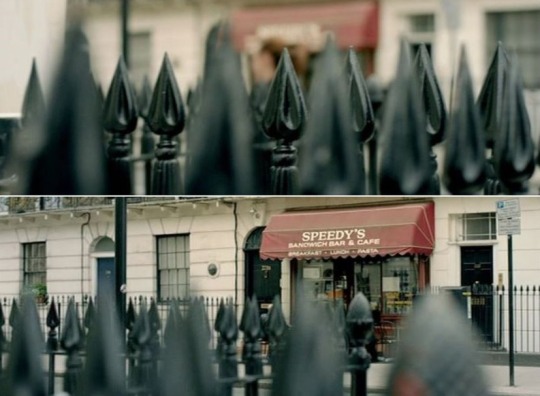
Three levels of spears stand like guardians in front of 221b Baker Street. Could those three levels symbolize the three stabbing victims of The Sign of Three? After all, each one of the three characters is depicted as guard, as protector ... and each one of them gets stabbed.
TBC below the cut ...

Stephen Bainbridge
He is a Private in the Household Guard of the Queen. The Grenadier Guards is an infantry regiment of the British Army. The current regiment is known as the 1st Regiment of Foot Guards … ’Every foot soldier bears the mark’ (Soo Lin, TBB). How surprising is it that the ‘East’ zooms in on Bainbridge before he gets stabbed by Jonathan Small?
Also … the gesture of the woman is interesting. Two Vs make a W (or a M … depends on the turning). It also lets me think of Culverton Smith’s W-gesture in TLD, in the short clip with the man disguised as cock (x).

Modern Grenadier Guardsmen wear a cap badge of a "grenade fired proper" with seventeen flames (x). Foot soldiers linked to exploding grenades … what a lovely coincidence, especially regarding the ‘passions’ grenade from TFP. :)

When the changing of the guards takes place, Bainbridge is already wounded and slowly dying. He got stabbed before the changing.
The name Stephen is of Greek origin and means ‘crown’ and ‘that which surrounds’. Saint Stephen was stoned to death and is regarded as the very first Christian martyr.
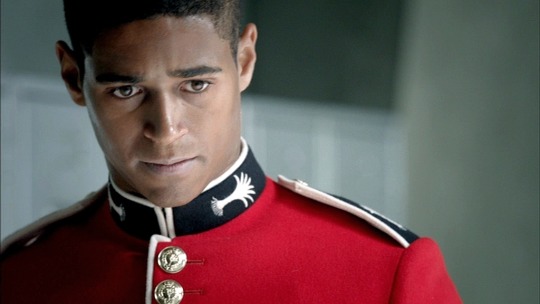
Another little detail caught my attention as well. Just a word used twice to describe a person.
SHERLOCK: “Elite Guard.” JOHN: Forty enlisted men and officers. SHERLOCK: Why this particular Grenadier? Curious.
And in TRF Sherlock sais:
SHERLOCK: This little boy; this particular little boy ... who reads all of those spy books. What would he do? JOHN: He’d leave a sign?
Max Bruhl left a sign. Stephen Bainbridge wrote a note. Not much of a difference, I think.
Guardsmen Max and Claudette
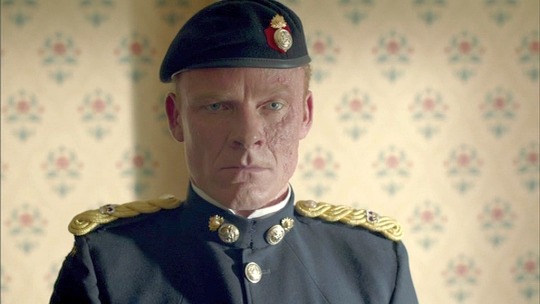
James Sholto
He is a retired Major of the Fifth Northumberland Fusiliers and Captain John Watson’s old commanding officer. A decorated war hero but not to everyone. Something went wrong when he led a team of new recruits into battle. ‘They all died’ (just like AGRA). Major Sholto, badly wounded, was the only survivor. Press and families gave him hell. Deaththreats and hate almost turned him into a recluse, into a most unsociable man, who spends his retirement way out in the middle of nowhere.
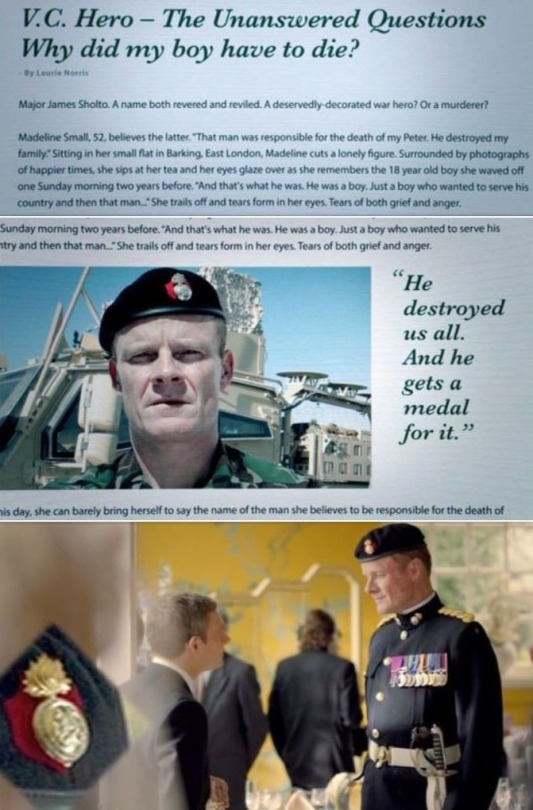
I’m quite sure this has been mentioned before, the 5th Northumberland Regiment on Foot (’foot soldiers’ too) still uses their ancient badge … St George killing the dragon (x) Every quiver of his beating heart
‘He destroyed us all’ … somehow these words sound very similar to the one Sherlock uses in TFP, in a situation where he considers himself to be a soldier: ‘Five minutes. It took her just five minutes to do all of this to us. Well, not on my watch.’
As mentioned above, Mary’s dialogue in TST matches the description about the incident with Sholto’s recruits almost identically … ‘something went wrong’/’but it went wrong’ … ‘I was the only one who made it our’/’they all died; he was the only survivor’. And Mary considered AGRA to be her family ... ‘we were family’.

Major John Sholto is an original character from ACDs novel The Sign of Four. His sons are called Thaddeus and Bartholomew. The renaming of the Major’s first name - from John to James - must have been a deliberate choice. A choice which is reflected in the skip code of TEH ‘John or James Watson … saint or sinner ... James or John’, as well as in John Watson’s middle name … Hamish (Scottish for James).
Major Sholto’s room number is ‘two oh seven’. This reminds me of the ‘double oh seven’ codeword for the ‘flight of the dead’ in ASIB. Two and double …. both means 2. Sure, the number on the door reads 207 but then, it happens several times in this story, that things told and things shown are sometimes not quite the same or vis versa.
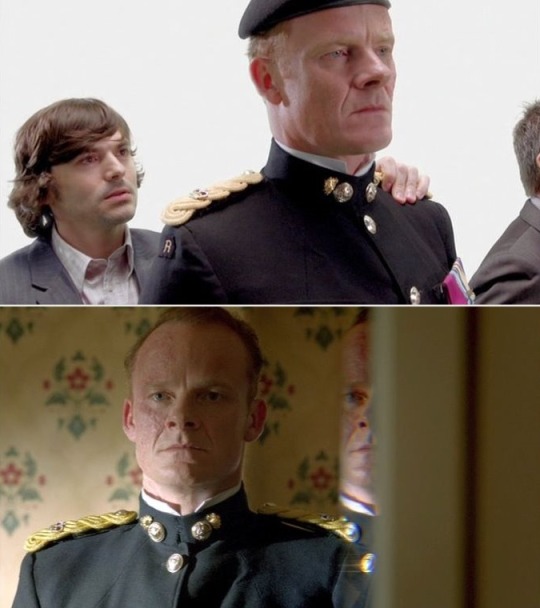
When the wedding guests leave the church and the reception takes place, Sholto is already wounded and slowly dying. He has been stabbed before.
Sherlock investigates the cases of both guardians
Bainbridge’s note reaches him sometime during the wedding preparations. John and Sherlock arrive just in time to save Private Bainbridge’s life. The case though remains unsolved.
Without knowing it at the time, Sherlock investigates Sholto’s case during John’s stag night. They call the investigation of the ghost-man the ‘Mayfly Man’ case. It remains also unsolved.
Sherlock includes both unsolved cases into his best man speech at John’s wedding and here at last, all the puzzle pieces fall into place and Sherlock is able to solve both cases, which are closely related. As a consequence Major Sholto’s life can be saved as well.
The person responsible for the attempts to kill Private Bainbridge and Major Sholto is:

Jonathan Small
‘Brilliant, ruthless, almost certainly a monomaniac - though, in fairness, his photographs are actually quite good’ … that’s how Sherlock describes the killer. Small’s motive is revenge. He is convinced that Major Sholto is responsible for the death of Small’s brother Peter, who had been among the killed recruits. It seems that Private Bainbridge merely had the misfortune and got randomly chosen for the rehearsal of Sholto’s murder. But ... why this particular 'foot soldier’? (I’ll come back to that question later)
Jonathan Small grins like Jim Moriarty and wears a checkered shirt like John. He is a brilliant, ruthless monomaniac and obviously also a womaniizer who has no problems to woo half a dozen women, almost at the same time, into telling him well-kept secrets. Basically … a perfect blend of Jim Moriarty and traditional John ‘three continents’ Watson.
Like Major Sholto, Jonathan Small too is an original character from ACDs novel The Sign of Four. His name has not been changed. Only together with his female and not-canon counterpart Janine, Mary’s bridesmaid, who seems to be a lovely blend of Irene and Jim, the name chosen for the antagonist of this episode, appears to gain a special significance.
Janine - deiminutive of Jeanne, female form of John … ‘little Johnny’
Jonathan - diminutives are Jon, Jonni ... though not related to ‘John’ regarding the meaning of the name, it can still be heard as … ‘little Jonny’ (’You can talk, Johnny-boy. Go ahead.‘ Jim, TGG)
None other than ‘little Jo(h)nny’ (the H makes the difference) is responsible for the almost murder of Private Bainbridge and Major Sholto, the first two stabbing victims of this episode.
‘Little Johnny’ also happens to be another word for penis … the ‘meat dagger’.
Who’s the third ‘victim’ then?

Mary Elizabeth Morstan
She is a character full of surprises who starts as a simple nurse who marries John Watson in TSOT. Among Sherlock’s deduction-word-cloud in TEH the term ‘guardian’ can be found and only one episode after the ���wedding’, Sherlock outs her as facade … his very own facade, because the Empty Houses in Leinster Gardens, on whose front walls Mary’s face is projected, are Sherlock’s property.
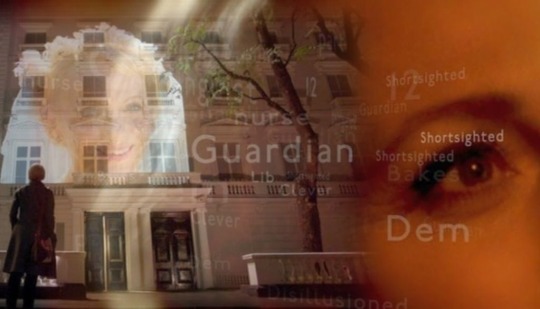
Mary Elizabeth Morstan isn’t her real name either. It’s the name of a stillborn child from a gravestone in Chiswick Cementry. This connects her character to the other stillborn child of this story ... Rachel Wilson, the pink lady’s daughter from ASIP. The initials A.G.R.A. stand for Mary’s true name, she tells later … but soon this turns out to be incorrect as well. A.G.R.A. was a group of four undercover agents who worked for the British Government. Prior to her ‘retirement’ Mary had been a member of that group. Sherlock describes her as ‘super-agent with a terrifying skill set’. Based on the current status, her two first names are Rosamund Mary … the family name is still unknown (if there even is one).
Why should Mary be the third stabbing victim?
Readers of my theories will probably know that I’m playing for a long time now with a mind palace scenario which stretches from the beginning, most likely in PILOT (or even before) to the end of S4 (x). Back then I wondered ...
Is it really so farfetched to consider the possibility that Sherlock tries to deduce and solve the mysteries and problems of his own live - and his falling in love with John - at first in his mind? Before he comes out?
Over decades - since ACD - the story of Sherlock Holmes and Dr. Watson has been told by the famous 'unreliable narrator’. Could it be that this time - with Sherlock BBC - the world will get the true story? Finally told by Sherlock himself? By looking right into his heart and mind and soul? By showing how his brilliant mind works? How his heart and soul expand and grow?
Would TPTB do such a thing? Stay in Sherlock’s mind over the span of multiple episodes? Follow his train of thought … show his evolution … in such a way? I don’t know. But it sounds thrilling to me. (Nov 2016)
Based on those early ideas I gradually came to the conclusion that Sherlock BBC tells the story of how Sherlock Holmes deduced his own persona. He does this the same way he investigates his criminal cases … by setting up scenarios in his mind and repeating those until he has found the correct solution (The Stage is set). Investigating his own case - the pink one - in such a way, would mean that all the characters which appear on Sherlock’s ‘mind stage’ represent different aspects of himself. Some of them may be based on real life persons, most of them are probably entirely created by Sherlock’s imagination. I like to compaire this process to a ‘mind journey’ or to a long (dramatic) dialogue, Sherlock holds with himself. This propably doesn’t happen during a dream or in a state of coma, as I thought back in 2016. A lot of time and thinking has gone by since then. Nowadays I presume that a conscious thinking process would fit better with the literal character Sherlock Holmes, whose deductions are always built on facts, science, reason and logic. It would be rather OOC that a man like Holmes would base an important, life changing decision on anything else than his razor sharp mind. Anyway, it’s just one of many theories.
Mary now … ever since I noticed the lot of similarities this character shares with Sherlock (x) my view on her started to change considerably. To me she isn’t the woman anymore who comes between Sherlock and John but instead the facade Sherlock Holmes created and married to his traditional, eternal friendship with John Watson for the sole purpose, to hide his romantic feelings and his sexual desire for the friend behind this protective wall. Mary is Sherlock’s facade, his guardian, his firewall … because:
John can’t ever know that I lied to him. It would break him and I would lose him forever – and I will never let that happen. Please … understand. There is nothing in this world that I would not do to stop that happening.
In my opinion, these are Sherlock’s own words and they express his fear of what might happen to the uinque friendship he shares with John, if the friend ever discovers the true nature of his feelings for him. Sherlock would do anything to stop that happening, even if this means that he has to incarcerate his emotions inside a high-security facility, behind elephant glass and chain his sexuality with iron bonds to a wall in a padded cell, like a hound from hell.
The ‘meat dagger’ incident
Sherlock tells the wedding guests - Major Sholto sits among them - about the unsolved Bainbridge case and asks if any of them has got a theory how that guard might have been stabbed. What kind of murderer can walk through walls, which weapon can vanish? Molly’s fiancé Tom (both characters are mirrors for John and Sherlock) assumes it could be a case of ‘attempted suicice by meat dagger’ ... something that would have been self administered.
A lot has been written since then about the ‘meat dagger’ as a metaphor for 'penis’ …. for ‘little Johnny’. :)

Sherlock sees only one feature of interest in the whole case … while he tried to solve the mystery, the eternal friend saved the life of the guard. And just the same happens a little while later with Major Sholto, the other guardian. It turns out that both men - both guardians - have been stabbed by the same killer … Jonathan Small … little Jonny, the meat dagger ....
There’s only one other character in this episode who has been stabbed unknowingly as well. That’s Mary. And in her case it’s indeed … ‘stabbed by meat dagger’ because Sherlock deduces her pregnancy by the end of the episode. Or expressed in computer language: the firewall has been penetrated by the virus.
The ‘father’ might be John or David, Mary’s ex. It doesn’t matter if one views the story metaphorically where all characters represent aspects of Sherlock himself. Going by his looks, David is clearly a mirror for John, while his history regarding the constant online observation of Mary, connects him to Mycroft, the brain. David seems to be a ‘blended’ mirror like Jonathan Small (John/Jim) or Janine (Irene/Jim). A mirror who represents the ongoing interest of the brain in the feelings hidden behind the facade.
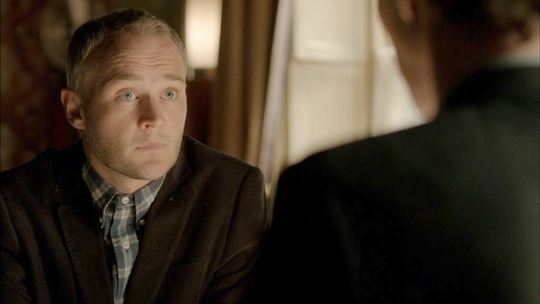
When Sherlock marries John and Mary, he puts a guardian in front of his true feelings for the friend. He tries to ‘downgrade’ those feelings. And yet, Sherlock allows three ‘social ancounters a year’ but ‘always in John’s - the traditional friendship’s presence’. That sounds very much like the ‘calculated risk’ Mycroft takes with Eurus. Both ‘brothers’ seem to be ‘love-addicts’ in need of a fix, once in a while … when the burden of ‘holding oneself to a higher standard’, of ‘keeping oneself right’ gets too heavy … or too boring. In that case it could propably happen that one takes the frustration out on the wall … then the wall has it coming … :)
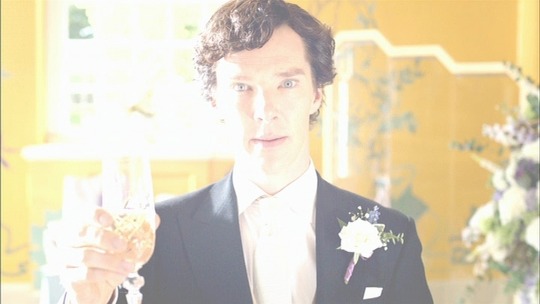
The moment of revelation
When Sherlock is blinded by the flashlight of ‘little Jo(h)nni’s’ camera, he suddenly realizes that the cases of Bainbridge and Sholto are connected. That the stabber has to be the same person. It’s the moment when the first domino piece falls and knocks over the next, and the next, and the next …. leading to a chain reaction of revelations at the end of which Sherlock knows without any doubt that his new facade had been penetrated again … this time though by a ‘kill shot’. He’d been hit by AMO (the perfect ammonition), fired by the crack shot that is his eternal friend. The seed of love has been laid without Sherlock noticing the ‘chink in his armour’ through which Cupid’s arrow hit home. Now love has taken root behind his facade and is growing.

The name chosen for that love is Rosamund - Rose of the world, as the dialogue in TST confirms. There’s a real rose of that name - Rosa Mundi - an old rose depicted in a work of Sandro Botticelli “Virgin Adoring the Sleeping Christ Child”. This rose is also known by the synonym ‘rosa versicolor’ - which means ‘rose of many or changing colours ... iridiscent’.
The word iridescence is derived in part from the Greek word ἶρις îris , meaning rainbow, It is the phenomenon of certain surfaces that appear to gradually change color as the angle of view or the angle of illumination changes. (X)
Sherlock - the ‘virgin’ he is called in ASIB by Jim and Irene - announces the pregnancy of Mary (I still wonder if this means that he is the 'Gabriel’ of A.G.R.A. - the angel who announces virgin Mary’s pregnancy). And during the stag night, John is labeled with ‘Madonna’. Another name for Virgin Mary. This turns the eternal friend also into the ‘virgin’, just like Sherlock and Mary. Another ‘sign of three’ one could say.
Three virgins - three novices - who will now start a new journey on a way they have never travelled before. Sherlock will finally encounter romantic love and accept it ‘it is what it is’, the facade will ‘get retired in a pretty permanent sort of way’ as the brain blatantly puts it in TST and the traditional ‘eternal’ friendship will have to change into a romantic-sexuell relationship. A morphing together of friendship and sex - John and James - would be a quite logical consequence, I guess.
In TST the little baby is christened with the name Rosamund, a name that can be traced back to ‘rainbow’ … Rosie for short. And rosy=pink!
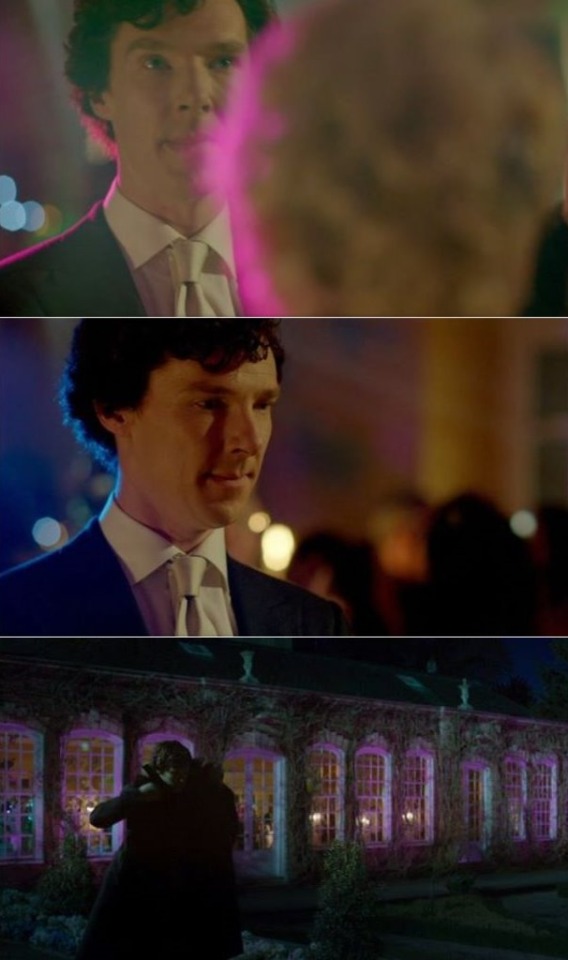
‘Oh, what a night! ... I was never gonna be the same … I felt a rush like a rollin' ball of thunder spinnin' my head around n' takin' my body under’
No wonder this song has been chosen by the creators to accompany this scene. Overwhelmed by emotions - surprise, confusion, amazement, shock, joy, panic, uncertainty, concern, fear - Sherlock isn’t able anymore to carry on with this ‘wedding’ .... with this renewed ‘changing of the guard’. He walks away alone into the night. The case is solved. Sherlock is aware of what happened. Now he has to deal with the consequences. Should he really replace his guardian again or should he finally stop pretending, stop lying, drop the facade and confess his deepest secret?
Because if you tell them and they decide they’d rather not know, you can’t take it back. You can’t unsay it. Once you’ve opened your heart, you can’t close it again.
This confrontation, Sherlock fights with himself, becomes the centrepiece of the following episode (HLV) where Sherlock is completely torn into. One half of his being, still protected by the facade, is at war with the ... ‘other one’, the slowly increasing emotional side of him. But somewhere deep inside his mind he probably knows already that this is a war ‘he must lose’. And so Sherlock has to go deeper ...
TAB doesn’t only take Sherlock back to his literal roots. In this episode Sherlock investigates again two of the main threads of the story and ties them together through the ‘bride’ … FALL and HOUND. Mary, the facade, feels already ‘left behind’ and John, who represents Sherlock’s now fully acknowledged, tender feelings, directed at his friend ... ‘does grow up so fast’. The episode ends with Sherlock, who throws himself into a torrent of water=emotions and follows Jim Moriarty, Mr Sex, down the Reichenbach Fall … right into the emotional rollercoaster that is Series Four.
Like the investigation in TAB, this series runs backwards as well. TST repeats the events of S2 and S3 while TLD zooms in on S1. I persume this happens because Sherlock applies an ability he describes to Dr. Watson as ... ‘reasoning backwards’:
“In solving a problem of this sort, the grand thing is to be able to reason backwards. That is a very useful accomplishment, and a very easy one, but people do not practise it much. In the every-day affairs of life it is more useful to reason forwards, and so the other comes to be neglected. There are fifty who can reason synthetically for one who can reason analytically…Let me see if I can make it clearer. Most people, if you describe a train of events to them, will tell you what the result would be. They can put those events together in their minds, and argue from them that something will come to pass. There are few people, however, who, if you told them a result, would be able to evolve from their own inner consciousness what the steps were which led up to that result. This power is what I mean when I talk of reasoning backwards, or analytically.” (ACD A Study in Scarlet, Conclusion)
There’s one important change though, which will alter everything. Sherlock now adds baby Rosie, the pink seed of love, the AMO-factor, to his equation. As a consequence his mask, his facade - that what ‘thatched’ and guarded him - crumbles and falls. And Sherlock accepts the change … It is what it is.
Then, in TFP, the third episode of S4, Sherlock puts the results of his deductions under the sharp lens of his emotional core, for the ultimate experiment … the final distillation … to produce at last a clear solution. Still missing is the chemical reaction that should follow the application of that solution, one might say. :)
Back to the three ‘guardians’
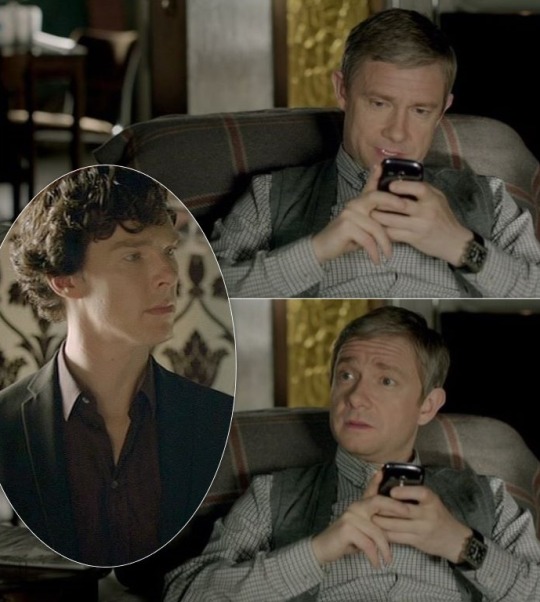
My husband is three people
During the wedding preparations, John tries to interst Sherlock for this curious case. John says the sentence ‘my husband is three people’ twice, interupted only by this short dialogue:
SHERLOCK: Major James Sholto. Who he? MARY: Oh, John’s old commanding officer.
Taking John’s words ‘my husband is three people’ literally, then he is talking about his own husband … which will soon be Mary. Husband, not wife, because Mary represents an aspect of Sherlock, his facade, his cover ... his ‘thatch’. As mentioned above, when Sherlock marries John to Mary, he puts a guardian in front of his true feelings for the friend … one could also say …. he places a commander at their/his side. And this is exactly what Mary does in later episodes. She decides who mowes the lawn, chooses the name of the baby and that it is her to take John home and not vis versa.
Husbands can be equated with facades, with commanders, with guards. All of them serve as protectors and defenders of Sherlock’s true feelings for the friend.
Who could have been the first ‘husband’ … the first facade, the first guardian?
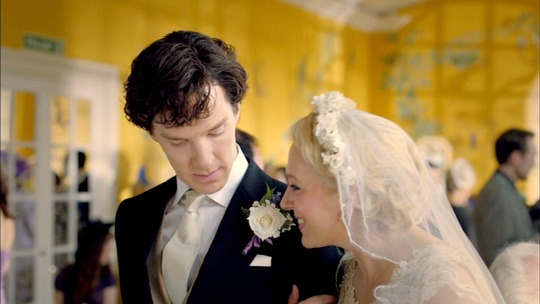
Neither of us were the first
This is what Mary tells Sherlock, while John welcomes his ‘privious’ commander. Is she really talking about sexuell experiences of her brand-new husband with another man, just to taunt Sherlock? Viewing the Mary-character as an aspect of Sherlock himself and not as a real wife that comes between two men, I heavily doubt this. Applying a metaphorical reading to the story, wouldn’t it be much more likely that this conversation is about their - Mary’s and Sholto’s - assigned profession. Neither of us were the first … guardian.
Mary is the husband to be, the most recently chosen facade, John’s new commanding officer, an undercover agent of the government.
Major James Sholto is John’s old commanding officer, Sherlock’s previous facade, which turned out to be not strong enough.
The only other guard in this story is Stephen Bainbridge, Private in the Household Guard of the Queen. The foot soldier named after Saint Stephen, the first martyrer.
And isn’t there somthing strikingly similar regarding those three guards as well as a noticeable increase in drama and strength, which so often happens when sequences are repeated on Sherlock’s mind stage?
Private Bainbridge guards the Queens Palace. The ‘East’ zoomes in on him, then he get’s stabbed by ‘little Jonny’ - the meat dagger - without noticing it. A changing of the guard takes place. Bainbridge almost dies beneath a shower of water.
Major Sholto guards the Queens country. He fights on a battlefield in the East beneath a burning hot sun. Something goes wrong and all the recruits under his command die. Badly wounded himself, Sholto has to leave the service and change into retirement. He gets stabbed by ‘little Jonny’ - the meat dagger - and almost dies.
Mary secretly works for Mycroft, the government, the ‘queen’ - as an undercover ‘super-agent with a terrifying skill set’. Her last operation took place in the East. Something went wrong and a lot of people died. It first looked as if Mary had been the only surviver (like Sholto). She marries ‘Johnny-boy’ Watson, gets stabbed by his meat dagger, becomes pregnant and …. dies not long after ‘PINK-RAINBOW-ROSIES’ birth.
The Sign of Three is about the ‘changing of the guard’. It takes place inside Sherlock’s head. But the marriage of John and Mary, that Sherlock arranges so heartbreakingly beautiful (and so strikingly yellow), turns out to be utterly pointless. Because the bride, the husband, the new commander, the facade is already pregnant ... had been stabbed before the wedding ... before the changing of the guard.
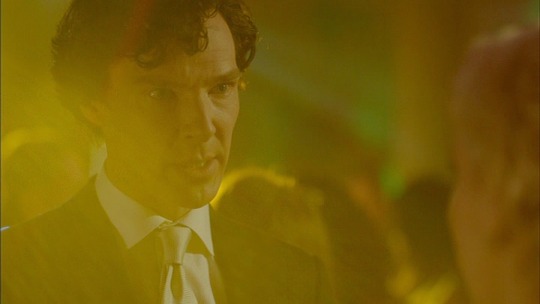
The Yellow Face connection
This isn’t new. It has been discussed before in this interesting meta About Yellow Face by @darlingtonsubstitution (sadly the part below the cut is gone) from 2017. As mentioned in the comments there, the creators of Sherlock BBC once refered to their favourite ACD stories. Yellow Face was among them but ... they wouldn’t be able to adapt it, because of the sensitive content, they said. This isn’t quite true though, it seems. On the contrary, the colour yellow features most prominently in Sherlock BBC … and not just the colour itself.
It starts with Sherlock’s and John’s first date at Angelo’s. The whole scene is drenched in yellow. PILOT even more than ASIP.
A secret code of ancient cyphers, sprayed in yellow paint, leads to the Yellow Dragon Circus.
Golden cats and big ‘yellow’ felines - lions - roam the story.
Yellow is the colour of the smiley face on the wall of the 221b living room.
There’s an assassin who carries a yellow ladder and a yellow tool case with a gun in it.
A bright yellow mask has been placed inside a box, alongside a train, a phone, nicotin patches and a note.
The main colour of the wedding ... bright yellow. It’s the wedding that leads Sherlock to the revelation ... to his love deduction.
A canary trainer, a trainer of yellow birds, turns out to be the killer.
Norbury, the case of the Yellow Face from canon, plays a vital role in TST
The finish of a race is marked with a bright yellow band that floats slowly to the ground while a ‘confessing’ serial killer, who is a mirror for John, passes as winner, signaling a W with his fingers, while the fingers from the ‘East’,, next to Private Bainbridge, signal a double V.
Yellow is the colour of the sun, of fire, flames and explosions.
Yellowbeard ….
But one of the most important links to Yellow Face is the following one:
JOHN: Mary, I may not be a very good man, but I think I’m a bit better than you give me credit for, most of the time. (Sherlock BBC, TST) 'I am not a very good man, Effie, but I think that I am a better one than you have given me credit for being.' (Grant Munro, The Adventure of the Yellow Face)
This piece of dialogue connects John to Grant Munro, the husband of Effie, the woman who hides her secret child from a previous marriage behind a yellow mask. She doesn’t do it out of some dark or sinister motive as Sherlock Holmes is convinced at first. Her former marriage had been legal and she'd loved her late husband dearly. Lucy, her little girl, can truly be called a child of love. But Effie fears to reveal Lucy, because the girl is ‘different' and the mother is anxious to lose the man she loves now, because of this. She is torn into between the love for her child and the love for her husband.
She (Effie) drew a large silver locket from her bosom. 'You have never seen this open.'
'I understood that it did not open.'
She touched a spring, and the front hinged back. There was a portrait within of a man, strikingly handsome and intelligent, but bearing unmistakable signs upon his features of his African descent. (ACD, The Yellow Face)
ACDs Yellow Face is a case without crime, without any devious betrayal. Instead, it’s about love and the fear to lose love, because at that time in ACDs story, it’s about a love not accepted by many.
'That is John Hebron, of Atlanta,' said the Lady (Effie), 'and a nobler man never walked the earth. I cut myself off from my race in order to wed him; but never once while he lived did I for one instant regret it. It was our misfortune that our only child took after his people rather than mine. (ACD, The Yellow Face)
In ACDs Yellow Face, the ‘first husband’ is of ‘African descent’ … just like Private Bainbridge, who is the ‘first guardian’ - the first of the three ��identical husbands’ - in Sherlock BBC, The Sign of Three. He is the one who represents Sherlock’s earliest facade … the guardian of the Queen’s Palace.

Just like @darlingtonsubstitution presumed more than two years ago, I’m now more convinced than ever, that Moffat and Gatiss did adapt ACDs Yellow Face and they not only included it in Sherlock BBC, they made it into the main theme of their story (beside ‘hound’, ‘fall’ and ‘scarlet/pink’). In their version though, the focus shifts from ‘unacceptable’ skin-colour to ‘unacceptable’ sexuality.
Sherlock BBCs baby ... Rosie ... Sherlock’s baby ... represents love. And this love is pink and has been given a name that can be traced back to ‘Rainbow’. The Sign of Three tells the story of the ‘changing of the guards’ and how Sherlock finally discovers the AMO-factor that will alter his life completely.
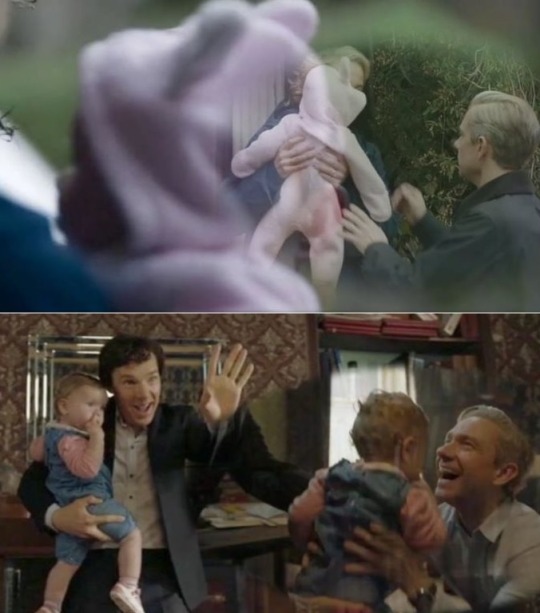
When I discoverd Sherlock BBC for the first time (back in 2011) I was thrilled by that fascinating crime drama and its two charismatic leads. Now, after 13 episodes, it has grown into so much more than just an excellent crime drama among others. The way I read it, Sherlock BBC is a wonderful and stunning story about equality. Inside Sherlock’s mind, the great detective doesn’t only solve the greatest secret of his life. No, the actors Sherlock chooses to represent the different aspects of his persona, are as diverse as the colours of the rainbow. They are old and young, male and female, beautiful and ugly, strong and weak, rich and poor. Neither gender, sexuality nor the shade of skin colour or from which corner on this planet someone comes, is of any importance. Anyone can be a part of this Sherlock Holmes. That’s what makes this adaptation so absolutely unique to me. Sherlock himself becomes the rainbow of his own story.
Thanks for reading to anyone who is still there. :)))) I leave you to your own deductions. And thanks @callie-ariane for your invaluable scripts.
December, 2019
________________________________________________________________
Episode spanning metaphorical reading of Sherlock BBC:
From PILOT to TGG …. About the meaning of S1
From ASIB to TEH …. The big question - what is the meaning of Reichenbach
#changing of the guard#sherlock bbc#metaphorical reading#the sign of three#guardians#commanders#husbands#edited pics
61 notes
·
View notes
Text
Twenty Titles meme
(x-posted from DW, and gakked from china_shop)
My last twenty fic titles on AO3:
A Jelly Good Show (Whitehead Holmes)
The Adventures of Goatratio Hornblower (Hornblower)
Tell-Tale (Hornblower)
The Taste of Truth (ACD Holmes)
New Year's Snow (Hornblower)
A Well-Rooted Briar (Hornblower)
To Make Dreams Truths (ACD Holmes)
Their Shared Will (Hornblower)
Seeking High-Energy Self-Starter, Flexible Schedule (My Dearly Beloved Detective)
HMK Nonsuch (Hornblower)
The Golden Sand (Hornblower)
Solace and Comfort (Hornblower)
Cock on the Right (Hornblower)
Opinions of her Own (Hornblower)
No. 36 Bannerman Road (The Sarah Jane Adventures)
Any Service Required (Hornblower)
Tea for Two (Moriarty - Horowitz)
A Tendency to Tease (Hornblower)
Kissing Lessons (Hornblower)
William Bush, Oldster (Hornblower)
1. How many are you happy with?
Fourteen, maybe -- I've vastly improved at titling in the last year or so. I require a title to be easy to remember and easy to match with the fic; ideally, a title should furthermore speak to some fundamental aspect of the story, or work at multiple levels. Over the last year, I've gotten better at identifying what is core about a story, and teasing out or devising a phrase that gets at it.
2. How many are... not great?
Eh, three? "Tell-Tale" comes annoying close to being a good title; it almost is a figurative descriptor of the gift as well as a literal one, and yet I'm not convinced it actually comes off. "New Year's Snow" is just blah. I mean, it's fine, but it does absolutely nothing of any kind of worth. "To Make Dreams Truths" is pure ugh: it's a line of poetry that doesn't QUITE fit, it comes off as annoyingly pretentious, I always have to squint at it a bit to remember which story it's supposed to be, I hate it.
3. How many did you scramble for at the last minute?
Nearly every single one -- eighteen were titled as part of prepping for AO3. At least one ("William Bush, Oldster") was actually first published without a title to tumblr. I have sometimes been tempted to keep those tumblr vignettes titleless when I pull them over to AO3, just write "Untitled" where it demands a title. But it's too cumbersome to have a bunch of things titled "Untitled" in my works list, so I've always given in at the last second and put something there.
4. How many did you know before you started writing/creating, or near the beginning?
"The Adventures of Goatratio Hornblower" and "Seeking High-Energy Self-Starter, Flexible Schedule" are the only two I knew well in advance, and it's probably not a coincidence that they're both silly, comedic titles for silly, comedic premises. In both cases, having the title in hand was very helpful in keeping me from losing my way with the stories: I kept drifting serious, then remembering that I had titled the thing "Goatratio" or that long horrible twist of management-speak, and then would use that to give myself permission to be silly and ridiculous again.
5. How many are quotes from songs or poems?
Two: "The Golden Sand" (Poe, "A Dream Within a Dream") and "To Make Dreams Truths" (Donne, “The Dream”). I'm happy with the former -- "Dream Within a Dream" is thematically spot-on for the fic, as is the image of the golden sand slipping through the dreamer's fingers while he weeps. My only discontent is that Poe is anachronistic for the Hornblower canon, but whatever, the stories were written in the 20th century and reek of their era, I don't care. Whereas the Donne... Eh, it's just not a great fit. It'll do, of course -- that's why I chose it -- but I don't like it, and the bad title almost makes me hate the story by association.
No, wait, I miscounted: it's three titles from story/song quotes. "Tea for Two" is obviously from a song, hello! I love it as a title -- such a perky, upbeat, happy song, imagining what a pot of tea can mean to a relationship, and meanwhile Moriarty has twisted that pot of tea -- and the underlying relationship -- into an evil caricature of the song's ideal. You know that thing they do in movies where they play something upbeat on an out-of-tune music box so it sounds evil and creepy and ominous? That’s how that title takes me, and I couldn't be happier with it.
ETA: I correct myself again! @educatedinyellow brought up "Cock on the Right," and THAT'S a quote, too, from a maritime rhyme extolling the benefits of various protective tattoos: <i>Pig on the knee, safety at sea; cock on the right, never beaten in a fight.</i> In my head, the title was a straightforward declaration of the story's most significant element -- the fighting cock tattooed on Bush’s right foot -- but it's actually a quote!
6. How many are other quotes?
Maybe ten of them are quotes from the story itself; another four or so might as well be direct quotes, being descriptions of a time or place in the story. Obviously, I find it very productive to dig into the text of the story for a phrase that sums up one of the central themes or problems of the story.
7. Which best reflects the plot of the story/content of the fanwork?
"Their Shared Will," possibly. Will is literally shared between them, obvs, but in-text it's a reference to his subbiness, and that what is getting him off is that they share a will about how to use him. It works perfectly on both levels, and both levels are a succinct and accurate summary of the fic.
8. Which best reflects the theme of the story/fanwork?
"The Taste of Truth," maybe. The title works literally, of course -- there's a fruit that you eat that allegedly tells you a truth, but it's a bitter, nasty fruit, and it tends to tell you cherry-picked truths designed to fuck you up to the maximum extent possible. Only a taste of truth, one designed to tantalize and ruin you. But the main action of the story is the characters experimenting with candid honesty, and so it's not just that bitter, nasty, poisoned truth they've been tasting, but also the good stuff, that which clears your palate and lays the foundation for fixing your life -- and maybe the taste of that is good enough to lead to better things. (I could probably have played more with that metaphor more at the end? Ugh. Maybe in some covert revisions...)
9. Which best reflects the character voice of the story/POV of the fanwork?
"A Jelly Good Show," possibly, being that the character voices are nothing but puns straight through. It was absolutely critical to give that story a punny title and summary.
10. Which is your favourite?
"The Adventures of Goatratio Hornblower," maybe. Distinctive and unmistakable -- I dare anyone familiar with the story to have trouble matching it to its title -- and an honest indicator of the kind of silly fun you're likely to find inside.
2 notes
·
View notes
Text
I thought I saw your post back then, but I just went looking for it and realised it was by @wohnjatson (this post). Anyway, I am amazed by the amount of brilliant and heartbreaking takes on Hound of the Baskervilles floating around lately!
The Hound of Watson's Grief
I made a post a few weeks ago about how all of the Holmes stories could be interpreted as Watson's imagination in order to compensate for his loneliness (sorry for putting that idea in your heads) and I wanted to expand on that by focusing on The Hound of the Baskervilles. So, prepare for some inarticulate rambling which I hope will make sense.
One of the things that has always struck me about this particular story is ultimately how different it is from the rest of the canon: not just Holmes' noticeable absence in the mid-section, but the emphasis on Watson's description and the supernatural features. Although these can still be seen in the other stories, The Hounds of the Baskervilles still seems to exist separately from them, and I have a an idea why this is.
The Hounds of the Baskervilles, as a story, was never meant to be. Holmes was dead- ACD was proud to announce that. He had rid himself of the so called 'great detective', and could focus on more historical serious novels. But, alas, he thought of an interesting story line, and could think of no other way of conceiving it without help from Holmes. So, Holmes was prematurely resurrected, without any form of indication that he was actually alive, or if this was D Watson writing up his notes, or if the audience should just suspend their disbelief and read the story as an undefined prequel.
Realistically, that is about all there is to say about the premise of The Hound of the Baskervilles: the story just is, and we have to accept that. But what of THotB is purely a work of fiction, including within the realms of the fictional world of Sherlock Holmes? In some ways, THotB could be read as Watson finding an outlet for his grief for Holmes.
Firstly, Holmes' absence: not just in the story, but in Watson's life and in the public's life. Holmes was dead, with no chance of return... supposedly. He had died offstage, with no witnesses, apart from the man who died with him, so no one could check with him if Holmes was actually dead. For Watson, the only proof he had of Holmes' death was a letter, with no body to bury; for a man who had spent so much time with someone so furtively based on facts, I can't imagine that that would have felt right to him. Holmes was dead, but where did he die? It's reasonable to suppose that Watson went through a stage of denial, believing that Holmes was still alive. Of course, he couldn't admit that to the public (like so many other things... the unreliable narrator that he is) so he would need another outlet. So, why not write a story involving Holmes? Maybe Watson began writing, including all the quintessential characteristics of Holmes (his quick deductions, sarcastic quips and his effortlessness in complimenting Watson), but then the realisation of his friend's death dawned on him. Watson looks back on his work, and remembers that he now must solve mysteries by himself. Holmes is busy elsewhere, and Watson is alone.
Watson begins a tirade of long, flowery descriptions (in the words of Holmes "cut out the poetry, Watson") which are usually skipped over in the shorter stories. We are fully immersed in the gloomy Dartmoor with its "tinge of melancholy", and the introduction of an escaped prisoner: Selden, the Notting Hill murderer. This feels like compensation for Watson forcing Holmes' logic in the earlier chapters, almost as though he's trying to build another story for himself. The addition of the Baskerville legend also seems more alligned with Watson's interests than Holmes: overall, THofB becomes more of Watson indulging himself in a fairy tale than reporting facts, as Holmes would prefer.
Still, Watson is just as dutiful as ever, writing letters to Holmes, but receiving little response. Again, this might be a parallel for Watson's life: he wishes to communicate with his late friend, but hears nothing back. Here, Watson might be doubting himself again: he's obsessing over Holmes' death, so much so that he can't be sure he's even dead. A glimmer of hope: maybe Holmes is alive, and he's out there, waiting to come back. Watson mentions "the figure of a man upon the tor", the "tall, thin man" which is undeniably Holmes: he allows himself this fantasy, to the point where he explicitly states this idea when he reveals that Holmes has been with him in Dartmoor all along, but hiding away from him. But, he can't be too certain, so Selden (who could be seen as a mirror to Holmes as he is confused with Holmes as being the figure on the Moor) is killed off as soon as Watson finds Holmes. Again, Selden is killed offstage and by falling off an edge, which sounds familiar...
Now, Watson has his Holmes back, in theory. He ends the story by describing Holmes being involved in other matters which he doesn't provide too much detail on, as per usual. The story was quickly and almost effortlessly resolved, with the antagonist, Stapleton, seemingly dead but the protagonist, Henry Baskerville, saved. I don't think it is too much of a stretch to say that Stapleton and Baskerville are Moriarty and Holmes substitutes, respectively (Stapleton's academic backgrounds and unusual characters; Baskerville's assertiveness, Watson's detailed descriptions of his movements and appearance, the implication that Selden's death was originally confused as his). So, here is another instance of Watson applying the narrative he wants, almost as though he's manifesting Holmes' resurrection.
I've thrown many ideas together which can probably be easily disregarded, but I tried rereading the story with this perspective, and I think it helped me make sense of certain aspects of the story which never sat comfortably with me. Although I'm not claiming to know the true reason why ACD wrote THotB, I do hope that you can understand the point I'm trying to make.
#the hound as a metaphor for trauma#i mean poor watson really went through a lot#i have read that other post a few weeks ago and kept thinking about it#so I'm glad here's more!!#honestly there are so so many great takes on tumblr for holmes adaptions#why is everything we get from 'official' adaptions so bad? XD#looks like we have to do everything ourselves but fine it's better that way anyway :)#sherlock holmes#acd canon#the hound of the baskervilles
54 notes
·
View notes
Text
Sherlock Holmes and Hannibal: Characters and Roles
Before I begin, I want to state that this is all for fun. I have done as much research as possible, but it has been surprisingly difficult to find links between Sherlock Holmes and Hannibal which are not about BBCSherlock Holmes. This analysis is about the connections between ACD Sherlock Holmes and NBC Hannibal, mainly because I finished watching it a few weeks ago and could not stop thinking about the similarities. Please take all this as, again, ‘for fun’. I wish I was able to write a comprehensive analysis that could be published in a media journal, but I probably won’t be doing that today. Additionally, any ideas that I write I am not claiming as my own as I am unsure if someone else has written them before, so I apologise if I haven’t credited people who need to be credited. If this is the case, please tell me and I will credit them. This theory largely relies on Holmes/Watson being canon and partially on Sherlock, Will Graham and Hannibal Lecter being autistic or at least autistic-coded. If you do not agree with these concepts, you definitely will not agree with this one.
Warnings out the way, let’s begin.
It’s very important to establish some of the main frameworks of the theory before I start building on them. From what you’ve possibly understood from the title, this is about Characters and Roles, which are similar to mirrors and foils.
Firstly though, another term I will be using is fictional person, or FP for short, just to avoid the confusion with Character.
Characters are essentially the personality of a fictional person and the decisions they are likely to make. For example, the character of Sherlock Holmes is a person of great intelligence, but only in specific areas, has difficulty expressing emotions, perhaps an addiction of some kind, and is isolated and queer-coded and autistic-coded. Other fictional people may follow this character, but it isn't always exact. You could describe Dr House as a Sherlock character (I understand he is essentially an adaptation of Sherlock Holmes, but because he is technically ‘based’ on him, this still works).
A role is the storyline of a fictional person, meaning that the FP will follow similar events and will play similar parts. However, the character does not always fit the role, which I will explain in detail when I’ve gotten the framework out of the way. Sherlock Holmes’ role is to be the detective or problem solver, companion/partner to Watson (either the Watson character or the Watson role), and perhaps fake their death or resurrect in a metaphorical sense.
Bear with me if this is getting confusing.
Hopefully, I’ve managed to explain Characters and Roles so that it’s understandable, now onto the building.
During my research to find already established connections between Holmes and Lecter, I found a Reddit page from seven years ago about people viewing Will/Hannibal as Sherlock/Moriarty. Understandable, because it is from a period where both shows were very popular. Again, this is not about BBCSherlock, but it is unavoidable for it not to be mentioned. I’ll insert a link to an article that includes more about that.
Personally, I do not agree with the Reddit users of 2016 (that was a fun sentence to write) but instead I view Will Graham and Hannibal Lecter both as Holmes Characters. Surprisingly enough I did not see a lot of comparisons between Will Graham and Holmes but I did find a lot of fanfic about them which really wasn’t what I was looking for (no judgement).
Graham, to me, stood out as being a very strong Holmes Character. From his clear autistic coding (I do not care about what Hugh Dancy said or refuted, Will Graham is an autistic man) to his ability to map out crime scenes in his head, he seems to be very clearly inspired by him. Even Graham’s tendency to take medication whilst in crime scenes to help him calm down is reminiscent of Holmes’ drug addiction. You can easily comb through Hannibal and the Holmes canon to find all the similarities. Personally, I believe that the lack of connection between the FPs is due to the misunderstanding around Holmes’ character. Both characters are caring and want to help people, which is a feature Holmes is not always recognised for. I do want to make this clear again, however: Characters do not always fit Roles, which is why Will Graham is not an adaptation of Sherlock Holmes.
Moving on to Hannibal Lecter now, deemed the clear candidate to be a Holmes Character. To be perfectly honest, I found it more difficult to link Hannibal to Holmes, since the connections I did find were more about the adaptations of Holmes, rather than the actual Character. I will add (because why not embarrass myself) that all I got at first was the fact that their first and second names both contain the same amount of letters which, to be honest, is a very extreme coincidence. A more definitive argument is the usage of Mind Palaces. In the ACD canon, although not coined as a Mind Palace, Holmes explains how he uses one; this is a method of loci, used by many other people, including Hannibal. Hannibal in fact uses the term ‘Mind Palace’, rather than ‘memory palace’, which is more commonly used. This seems like a direct connection between both FPs. Adding to this, Hannibal is known to take personal pride in his appearance, similar to Holmes and is also shown to have an addiction of some kind (in Hannibal’s case, this is cannibalism, slightly different to doing drugs I suppose). Another point is Hannibal’s backstory turning him into ‘who he is’, a commonly discussed topic for Sherlockians on how Sherlock became Sherlock. Like Will Graham, you can rewatch the series and find all the similarities, but the argument is there: Hannibal Lecter and Will Graham are Holmes Characters.
If it wasn’t confusing enough, I’m about to confuse you even more.
We’ve now established who their Characters are, now let’s move on to Roles. Neither of them are Holmes Roles, reason being that Sherlock at no point pulls a Loki and falls in love with himself (This joke only makes sense if you’ve watched the Loki series but essentially Loki falls in love with another variant of himself). This couldn’t be even framed in a metaphorical way, where Holmes becomes so enamoured by his intelligence and solidarity that the chivalrous, caring side joins with it (that even confused me) as Holmes does not show a lot of love for himself. Adding to this, the relationship between Hannibal and Will is difficult to describe. In some way it’s possessive, it’s bringing out the worst in each other, it’s manipulative, it’s sexually motivated (these are not all my opinions, just what I understand others believe). If you were to argue that Will Graham was both a Watson Character and Role, which would leave Hannibal to take on the Role of Holmes, it still wouldn't make sense because Holmes and Watson’s relationship is defined by their love for each other as people, not as heroes.
In all fairness, it is a fair argument to view Graham with a Watson Role, which is what I am establishing for this theory. Graham does in fact love Lecter; this is an undisputed fact, clarified by the final series. It’s canon. Graham, like Watson, is amazed by the Holmes Character's skills and wants to find out more, which can sometimes be a mistake. He is brought into the world of crime through the Holmes Character and (this is not the strongest argument, but if you look at it as, if it wasn’t for Hannibal killing people, Jack Crawford likely wouldn't have asked for Graham’s help). In a way, this can work apart from two important details, the first being Will Graham’s Character. As a Holmes Character, this admiration is not always shown and can lead to disputes. He is intelligent, like the other Holmes Character, and equally as strong-willed, leading to Graham’s and Lecter’s disagreements.
The second reason why this does not work is due to Hannibal’s role: Moriarty. I will admit, I am taking a lot of guidance from BBCSherlock for this one, but it still involves the ACD canon. To understand this, you will need to understand the idea of Moriarty being obsessed with Holmes, in a way that he believes is love but clearly is not. I do want to highlight that this is a one-way relationship- I in no way shape or form believe that Holmes loves Moriarty, and I’m speaking for every adaptation I have seen. This is essential to know. Because there is no reason to suggest otherwise, this theory works for ACD canon: the idea that Moriarty has been waiting in the shadows for Holmes to find him, so that he can take the opportunity to mould him into his right-hand man. It is clear from the start that Hannibal wants to see the lengths Will would go and he often tests him to see if he can coerce him to kill or even become a cannibal like himself, which Hannibal is successful in. He even goes as far as framing Will Graham for murder, but instantly regrets it, which is where his Moriarty Role is replaced by his Holmes Character. He wants to see 'what will happen’ similar to how both Holmes and Moriarty are testing similar things. With Moriarty, these ‘things’ are more about actively killing people, rather than seeing if someone will confess, like Holmes.
Perhaps it might be easier to view Hannibal purely as just being Moriarty, and I do understand that view. But, the biggest factor which goes against this is the love Hannibal has for Will Graham. Will is still a Holmes Character, but his role is Watson to Hannibal’s Holmes Character. Unlike Moriarty, he genuinely does love him, which goes further past obsession. Hannibal is Will’s Moriarty, Will is Hannibal’s Holmes. This is why it doesn’t not fit the Character’s or the Roles exactly, because these two relationships could not exist within the ACD canon.
As mentioned before, Will and Hannibal’s relationship is largely seen as ‘obsessive’ which can in some ways be seen from both sides, but largely with Hannibal. Hannibal is instantly captivated by Will from the start, and this obsession continues. The reason why I stated that, within a Moriarty Role, it is important that this relationship is one-sided is due to Will Graham essentially rejecting Hannibal multiple times, the most pivotal being when Hannibal gave himself up due to Will Graham saying he doesn’t want to think about him. The Holmes Character is not in love with Moriarty, therefore Will Graham does not always want to be with the FP in the Moriarty Role. To counter this, Will Graham also plays the Watson Role, who does want to be with the FP with the Holmes Character. This adds the complexity to the relationship, and the complexity to this theory which is getting more and more confusing.
Finally, this idea is brought together in the final episode of Hannibal. Here, Graham has let go of his Watson Role, submitting to the Moriarty Role and becoming what the Moriarty Role wants him to be. In, what I believe, a direct homage to The Final Problem, both the Holmes Characters, along with the Moriarty Role, fall over the edge, like in the story. The main difference: they chose to go together. Perhaps Will let go of the Watson Role, but he didn’t let go of his love for Hannibal.
So, that's how I've connected Sherlock Holmes to NBC's Hannibal. If you disagree, that's fine, it isn't the strongest argument. If you are very confused, don't worry, so am I.
I am hoping to read the Hannibal books soon, so I might add on to this.
This is the link I mentioned.
17 notes
·
View notes
Text
me reading the Moonlight script like, please tag your porn???? skdjfksjfkh i should just liveblog this shit, i’m seeing gay shit in there and i blame tjlc fandom. thanks everyone, it’s very entertaining
eta: ah yes, apparently it’s not allowed to shitpost in the middle of the night while having a good time w/o explaining exactly what you meant with a 5k word essay, no, the fandom police will jump down on your ass and tell you to shut up w/o knowing any context or who the blogger is and where they’re coming from. please kindly fuck off???
#candles rambles#what is sleep anyway#just metaphors yo#but about as gay as acd canon lbr#.#moonlight
5 notes
·
View notes